Russian Invasion of Ukraine; then and now
editorial comment;
History will not be kind to the Trump Administration’s about-face policy support of a democratic Ukraine and its people. Since President Trump took power, in January 2025, we have witnessed a reversal in American policy and values; in their place a Let’s Make Deal foreign policy without merit, without American values, ignorant of history and future consequences.
Russia launched its full-scale invasion of Ukraine on February 24, 2022. This date marks the start of the 2022-present phase of the ongoing Russo-Ukrainian War, which dates back to the Russian invasion and 2014 annexation of Crimea and the conflict in Donbas, but a deeper and connected history between Ukraine and Russia dates back before the communist revolution of 1917. In the 21st century, Ukraine’s national survival in its present form as democratic state is not only important to Ukraine, but the West as well. Which explains America’s support for Ukraine and its people. As of late 2024/early 2025 data, the United States has allocated approximately $175 billion to $183 billion in total aid to Ukraine, and in related regional support since the start of Russia’s full-scale invasion in February 2022.
A good economist not only looks at benefits as well as costs, but also asks “and then what?” Will Russia be content with Ukraine? It is already threatening Moldova and (the rest of) Georgia. Ramzan Kadyrov, President of Chechnya and a key Putin ally, has stated that Russia will attack Poland after they finish with Ukraine. He has also declared that East Germany is Russian territory. What would it cost Americans if a combined Russian-Ukrainian military invades Poland or East Germany?
November – December 2025
Shake-up or Shake-down
The resignation on Friday (11-25) of Andriy Yermak, Ukrainian President Volodymyr Zelensky’s most trusted and powerful lieutenant, should hearten supporters of Ukraine. While Yermak’s departure is likely to unsettle the government, as various players struggle to fill the vacuum he leaves behind, that turbulence will be short-lived. If he plays his cards right, Zelensky could emerge from this crisis stronger, with his legitimacy bolstered and better situated to sell difficult decisions to his countrymen.
Democracy is making a comeback in the war-weary country, and that’s a good thing. Martial law, imposed immediately after Russia’s full-scale invasion in 2022, has allowed Ukraine to keep fighting — but at a cost, including no elections. In the pursuit of streamlined decision-making, Zelensky has concentrated power around himself. Yermak personified that.
Peace Negotiations Update – give peace a chance? …
The Washington Post reported (update: 11-25) …
A peace plan that would somehow be acceptable to all sides and end nearly four years of war came into public view as dozens of Russian missiles slammed into Kyiv overnight, hitting apartment buildings and power infrastructure. Lt. Col. Jeff Tolbert, a spokesman for Secretary of Defense (War) Daniel Driscoll, said the talks are continuing through Tuesday, with the Russian delegation in Abu Dhabi summing things up this way… “are going well and we remain optimistic.”
A Ukrainian delegation is also in Abu Dhabi, a U.S. official said, “and has been in contact with Secretary Driscoll and his team.” He, like others interviewed, spoke on the condition of anonymity because of the sensitivity of the issue. Top Ukrainian official Rustem Umerov said Tuesday that Zelensky would be headed to the U.S. to finalize the deal with Trump this month. Ukrainian official cites ‘common understanding’, but no sign of territorial concessions or security guarantees have been agreed to at this time.
The original plan, which was widely criticized by the Ukrainians and Europeans as being too pro-Russian and a capitulation for Ukraine, was endorsed Friday by Russian President Vladimir Putin as a possible basis for peace. Most analysts think the latest changes will be unacceptable to Moscow, leaving Russia with the choice of trying to revise the draft deal once more or rejecting it outright.
In his comments to the Russian Security Council last Friday, Putin declared that Russia was “happy” to fight on and defeat Ukraine through military means. Russia launched a punishing missile and drone attack against the Ukrainian capital overnight, striking residential apartment buildings in several neighborhoods and killing at least seven people, the latest in a series of attacks on civilian infrastructure that seem designed to increase the pressure on Ukraine’s civilian population to break the nation’s resistance. Russia further targeted several other regions in Ukraine, including Chernihiv, Dnipro and Kharkiv.
US army secretary briefs ambassadors at ‘nightmare meeting’ in Kyiv on Friday (11/21) after talks with Ukrainian leaders. US officials further told NATO allies they expect to push president Volodymyr Zelenskyy into agreeing to a peace deal in the coming days, under the threat that if Kyiv does not sign, it will face a much worse deal in future.
The US army secretary, Dan Driscoll, briefed ambassadors from NATO nations at a meeting in Kyiv late on Friday, after talks with Zelenskyy and taking a phone call from the White House. “No deal is perfect, but it must be done sooner rather than later,” he told them, according to one person who was present. The mood in the room was sombre, with several European ambassadors questioning the content of the deal and the way in which the US had conducted the negotiations with Russia without keeping allies informed.
“It was a nightmare meeting. It was the ‘you have no cards’ argument again,” said the source, referring to Trump’s claim that Zelenskyy had no cards to play, during a contentious White House meeting back in February.
Zelenskyy to negotiate with Trump over US-Russia peace deal requiring painful concessions
The Ukrainian president, Volodymyr Zelenskyy, has said (with little leverage) he will negotiate with Donald Trump on a US-backed peace plan that called on Kyiv to make painful concessions in order to end the Kremlin’s invasion of his country.
Zelenskyy’s office on Thursday confirmed that he had received the draft peace plan prepared by US (Trump’s peace at any cost White House inner circle) and Russian officials, and that he would speak with Trump in the coming days about “existing diplomatic opportunities and the main points that are necessary for peace”.
“We agreed to work on the points of the plan so that it would bring a worthy end to the war,” Zelenskyy’s office said in a statement.
The cautious response from Ukraine’s presidential administration followed angry denouncements of the plan by some Ukrainian officials who called it “absurd” and unacceptable. Zelenskyy’s public statement came as he held talks on Thursday with a high-ranking US army delegation.
Other officials in Kyiv said the proposal reportedly drafted by Kirill Dmitriev, a close ally of Vladimir Putin, and Donald Trump’s special envoy Steve Witkoff was a “provocation”, the aim of which was to stir up division and “disorientate” Ukraine’s NATO allies.
One-sided Surrender
The Russia-concocted peace plan envisages Ukraine giving up the northern part of the Donbas region, which it controls, to Russia, and cutting the size of its army in half. Ukraine would also be forced to relinquish its long-range weapons, used to strike military targets inside Russia, and never join NATO – terms of an invader operating free of constraints. Additionally, no foreign troops would be allowed on Ukrainian soil, a condition that rules out a post-deal peacekeeping force led by the UK and France. But the US would provide unspecified security guarantees, according to Axios
Ukraine’s first deputy foreign minister, Sergiy Kyslytsya, called the initiative unrealistic. He suggested it was a classic Soviet-style information operation to influence opinion and sow panic.
According to media reports, the sweeping 28-point proposal closely resembles demands made by Moscow soon after its full-scale invasion in early 2022. It was reportedly drawn up by Russian and US officials, with support from Donald Trump. Kyiv was not consulted…
October- November 2025 – the war grinds on …
Russian forces had pushed further into Pokrovsk and its environs, though much of it remained beyond firm control of either side, mapping by the Ukrainian project DeepState indicated on Tuesday. “The situation remains critical,” said Deepstate, adding that in some districts Russian forces were digging in and building up positions.
Volodymyr Zelenskyy also visited troops in the Pokrovsk area of Donetsk oblast on Tuesday. “I met with our warriors at the command post of the 1st Corps of the National Guard of Ukraine Azov, which is conducting a defensive operation in the Dobropillia sector,” said the Ukrainian president, referring to a town about 20km (12 miles) from Pokrovsk. Earlier, Zelenskyy urged the US to remain open to supplying Kyiv with long-range weapons. Addressing a European Union summit from the Pokrovsk area, the Ukrainian president also called for more western sanctions on Russia – including on Russia’s gas and nuclear sectors – and said he wanted Ukraine to join the EU before 2030.
The Institute for the Study of War (ISW) said in its most recent assessment at time of writing, posted on 3 November: “Russian forces continue to advance in the Pokrovsk direction and appear to be operating with increasing comfort within Pokrovsk itself.” The ISW added that Ukrainian forces had liberated a significant portion of a Russian penetration in the Dobropillia direction, on the eastern flank of the Pokrovsk effort.
Other recent war developments
Ukrainian long-range drones attacked an industrial plant about 1,300km inside Russia at Sterlitamak, local officials said on Tuesday. The city administration reported an explosion at the Sterlitamak Petrochemical Plant that caused its water treatment facility to partially collapse, adding that the cause of the explosion was not known. The Ukrainian military general staff said there was “considerable damage” to the plant.
Ukraine’s military said it struck a Lukoil oil refinery at Kstovo in Russia’s Nizhny Novgorod region east of Moscow. The extent of the damage was being assessed, it said. The Russian regional governor confirmed an attack by 20 drones near Kstovo.
Russian military reservists will now have to guard oil refineries against Ukrainian drone strikes after Vladimir Putin signed a law on Tuesday extending their entanglement in the war effort.
Heavy military spending has also started to strain the Russian state budget, with Moscow raising taxes to plug a rising deficit.
September 2025 – the war heats up …
Russia grinds forward in the east
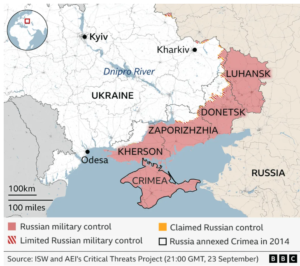 In eastern Ukraine, Moscow’s war machine has been churning mile by mile through the wide open fields of the Luhansk and Donetsk regions – also known as the Donbas – surrounding and overwhelming villages and towns.
In eastern Ukraine, Moscow’s war machine has been churning mile by mile through the wide open fields of the Luhansk and Donetsk regions – also known as the Donbas – surrounding and overwhelming villages and towns.
It has been trying to gain full control of the area along with two more regions to the west – Zaporizhzhia and Kherson. Shortly after the invasion, Russia held referendums to try to annexe all these regions – in the same way it had annexed Crimea in 2014 – but it has never had them under full control.
Putin preparing to attack another European country, Zelenskyy says
Speaking in Kyiv after his meeting with Donald Trump at the UN in New York, the Ukrainian president said Russia was preparing for a bigger conflict.
Ukraine’s president said Friday (9-27) that the Kremlin is testing Europe’s capacity to protect its skies following new drone sightings. Vladimir Putin will expand his war in Ukraine by attacking another European country, Volodymyr Zelenskyy has predicted, and accused Russia of recent drone incursions that he said were an attempt to test Nato’s defences.
Ukraine’s president said the Kremlin was deliberately checking Europe’s capacity to protect its skies, after drone sightings in Denmark, Poland and Romania and the violation of Estonian airspace by Russian fighter jets. More drones were spotted on Friday night above a Danish military base, and over a Norwegian base on Saturday.
In recent months Kyiv has carried out a series of successful strikes against Russian oil refineries using domestically produced long-range drones. Zelenskyy said that if the Kremlin tried to destroy Ukraine’s energy infrastructure again this winter its own capital will experience retaliatory blackouts.
Nato confirms Russian MiG-31s over Estonia and Poland airspace
Russian jets violated both NATO member countries, including oil platform safety zones in the Baltic Sea, incursions well inside NATO countries
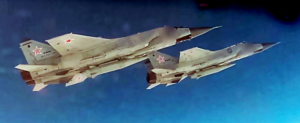 (Sept. 19,2025) Poland with the country’s Border Force reporting that two Russian fighter jets violated the safety zone of the Petrobaltic oil and gas exploration platform in the Baltic Sea by performing a low pass (buzzing) the Polish oil platform, well inside and its territory.
(Sept. 19,2025) Poland with the country’s Border Force reporting that two Russian fighter jets violated the safety zone of the Petrobaltic oil and gas exploration platform in the Baltic Sea by performing a low pass (buzzing) the Polish oil platform, well inside and its territory.
(Sept. 26,2025) Russian incursions were also cited in Estonian airspace ‘direct threat to transatlantic security,’ Ukrainian foreign minister said earlier in a statement that “today’s incursion of three Russian fighter jets into Estonian airspace is another Russian escalation and a direct threat to transatlantic security.”
German foreign minister, Johann Wadephul, said ‘This principle of Nato has lost none of its relevance. The unacceptable violations of Polish and Estonian airspace by Russia today and earlier demonstrates this with utmost clarity.”
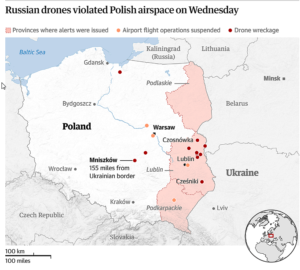
A lot about this event and others recently demonstrate the Russian incursions of fighter jets and drones into NATO border countries is clearly intentional. One drone might go astray, but this was more than a dozen drones entering Polish territory, even as none appear to have been reported in Slovakia, Hungary, and Estonia, all neighboring NATO countries to Russia’s border. As one military expert stated, “That’s how Putin operates: He tests and measures the reaction. If this challenge to NATO is met with nothing more than indignant tweets, he will escalate further. He is trying to bully NATO countries into backing away from supporting Ukraine, as he has bullied so many others.”
Whatever Donald Trump discussed with Vladimir Putin in Alaska last month, the outcome has only been a stepped increase in Russian aggression that has now forced Nato’s military into action. On Tuesday night 19 Russian drones entered the country’s airspace, according to the prime minister, Donald Tusk – a number that cannot be easily explained away as accidental.
Until that point, Russia’s war in Ukraine had not spilled over in a notable way to a Nato country. Though the drone incursion cannot be described as militarily significant (only one house has been reported damaged so far) the Polish incident is qualitatively different from anything that has happened since February 2022.
Speaking on Wednesday, UN spokesperson Stephane Dujarric said: “The incident… again underlines the regional impact and real risk of expansion of this devastating conflict.”
European leaders told the Associated Press they believe the incursion was an intentional expansion of Russia’s war on Ukraine rather than being a mistake. “Russia’s war is escalating, not ending,” European Union foreign policy chief Kaja Kallas told the AP; “What Putin wants to do is to test us”.
This is not unexpected. Military officials have long been concerned that Putin might intensify Russia’s war in Ukraine by striking Ukrainian supply lines in Poland, but until now he apparently has calculated that the risks are not worth it. I wonder if he believes that President Trump’s refusal to hold Moscow accountable so far makes this a good time to see if he can get away with attacks on NATO territory.
NATO scrambles jets to shoot down Russian drones in Poland, raising fears of war spillover
European countries need to work on a “joint air defense system and create an effective air shield over Europe,” Ukrainian president Volodymyr Zelenskyy said on Wednesday;‘We need to work on a joint air defense system…over Europe’. “We need to work on a joint air defense system and create an effective air shield over Europe. Ukraine has long proposed this, and we have concrete solutions. We must respond together to all current challenges and be ready for potential threats to all Europeans in the future. Likewise, we need to significantly increase joint funding for the production of interceptor drones. They have already proven their effectiveness.”
There are several lessons Europe and the US should take away from Russia’s unprecedented decision to send drones into Poland as part of another Kremlin attack on Ukraine.
One is that nobody should ever again dismiss the idea that Russia—struggling so mightily in Ukraine—would ever take on a North Atlantic Treaty Organization member. It just did, Champion writes. Nineteen drones entered Polish airspace, according to Foreign Minister Radek Sikorski, enough to make clear it was deliberate and for Poland to invoke NATO’s Article 4, calling on allies to consult when a member is under threat.
August 2025
- Ukrainian President Volodymyr Zelenskiy and US President Donald Trump expressed hope that their White House summit Monday with European leaders could eventually result in trilateral talks with Vladimir Putin over ending Russia’s war on Ukraine.Ukraine’s European allies arrived in Washington (8-18) skeptical that Putin really wants peace, and apprehensive that Trump will try to force Kyiv into making unpalatable concessions.
- The Republican president has long echoed Kremlin talking points when it comes to the war, including that Ukraine should give up territory to end Russia’s onslaught.
- President Zelenskiy and EU allies met with Trump earlier today, a meeting arranged hurriedly after the one-on-one Trump-Putin in Alaska last Friday. The meeting takeaway was the onus was on Zelenskiy to-end-the-conflict.
- Ukrainian officials view of the latest round of hope and peace talks were difficult to balance expectations as Russian attacks escalate, and Putin continues to demonstrate he does not intend to stop the hostilities short of Ukraine’s surrender.
Russia can only be forced into peace through strength’, Zelenskyy says as he bids for Trump’s backing
August 18th; Ukraine’s President Volodymyr Zelenskyy met with US envoy Keith Kellogg ahead of what he described as a “very serious” meeting with Trump and other European leaders later today.
“When peace is discussed for one country in Europe, it means peace for all of Europe. We are ready to continue working with maximum effort to end the war and to ensure reliable security. These are the key issues.
Last night, Russian attacks on our cities continued – among those killed were two children, and dozens of people were wounded. People were simply sleeping when the Russian army launched strikes on the cities.
We discussed the battlefield situation and our strong diplomatic capabilities – Ukraine’s and all of Europe’s together with America. Russia can only be forced into peace through strength, and President Trump has that strength. We have to do everything right to make peace happen.
US president Trump will meet with Ukraine’s Volodymyr Zelenskyy first in about an hour from now, with the Europeans only joining the talks later.
On the European side of the table, there will be one notable absence as Poland will not have a representative, despite being part of the previous rounds of consultations with Trump, including days before the Alaska summit last week.
Since his election, the country’s new nationalist and Trump-backed president, Karol Nawrocki, has been at loggerheads with the pro-European coalition government led by former European Council president, Donald Tusk, including over who owns the relationship with the US.
On the European side of the table, there will be one notable absence as Poland will not have a representative, despite being part of the previous rounds of consultations with Trump, including days before the Alaska summit last week.
Since his election, the country’s new nationalist and Trump-backed president, Karol Nawrocki, has been at loggerheads with the pro-European coalition government led by former European Council president, Donald Tusk, including over who owns the relationship with the US.
‘Russia can only be forced into peace through strength’, Zelenskyy says as he bids for Trump’s backing
Last night, Russian attacks on our cities continued – among those killed were two children, and dozens of people were wounded. People were simply sleeping when the Russian army launched strikes on the cities.
We discussed the battlefield situation and our strong diplomatic capabilities – Ukraine’s and all of Europe’s together with America. Russia can only be forced into peace through strength, and President Trump has that strength. We have to do everything right to make peace happen, Zelenskyy said.
July 2025
Trump does indirect deal through Nato surrogates to arm Ukraine, and warns Russia of severe sanctions
President Trump says he will supply Kyiv with billions of dollars of military equipment paid for by European allies, promising large-scale arms deliveries to Ukraine, including Patriot missiles, and he also warned Russia that it will face severe sanctions if Moscow does not make peace within 50 days.

Speaking in the White House alongside a clearly delighted Rutte, the US president said the arms deliveries would be comprehensive and would include the Patriot missile batteries that Ukraine desperately needs for its air defences against a daily Russian aerial onslaught.
“It’s everything: it’s Patriots. It’s all of them. It’s a full complement, with the batteries,” Trump said.
He did not go into any more detail, but made clear the weapons would be entirely paid for by Washington’s European allies, and that initial missile deliveries would come “within days” from European stocks, on the understanding they would be replenished with US supplies.

Russian Drone Attacks – death by a thousand cuts
Hundreds of Russian drones flying from all directions attacked Kyiv overnight into Thursday (7/10) in an apparent new Russian tactic, marking a second consecutive night of ferocious attacks on Ukraine.

Russia has been intensifying its aerial attacks against Ukraine in recent weeks, but the assault on Thursday appeared to mark a change in approach from Moscow.
Russia launched 400 drones and 18 missiles, including eight ballistic and six cruise missiles, according to a Telegram post from Ukrainian President Volodymyr Zelensky.
They were flying at different altitudes, and attacking from all directions — with some of the drones initially bypassing the capital before abruptly changing direction and speeding back towards the city.
While Kyiv has previously experienced attacks from multiple directions, as Russian drones attempted to bypass the city’s air defenses, the assault on Thursday saw the drones launching towards the city simultaneously, effectively encircling Kyiv before attacking. This made guarding the capital’s skies even more challenging for the strained Ukrainian air defenses. Yet the Ukrainian Air Force said it shot down or disabled 382 of the 415 aerial weapons Russia launched at the country overnight, including all of the ballistic and cruise missiles. That is a stunning success given the scale of the attack, especially given Ukraine’s limited access to air defense systems.
U.S. Policy Flip Flop
President Trump has often expressed, without merit, his skepticism of U.S. aid to Ukraine and admiration for Mr. Putin. In recent days Trump’s tone has shifted as the realities of this war have begun to reshape this new President’s thinking and policy now guiding US support for Ukraine.
On Monday, Trump said in an about face that he was “not happy with President Putin at all” and announced that the United States would reinstate US weapons supplies to Ukraine to assist fending off Russia’s ongoing and escalating aerial attacks on the Country. Trump’s comments contradicted his administration recent policy shift in cutting off military aid to Ukraine. On Tuesday (7/08), and in a awakening moment, Mr. Trump stepped up his criticism of Mr. Putin, accusing him of duplicity. “We get a lot of bullshit thrown at us by Putin, if you want to know the truth,” Trump told reporters during a recent cabinet meeting. “He’s very nice to us all the time, but it turns out to be meaningless.”
Russia’s sustained assault in recent days has injected new urgency into questions surrounding Washington’s commitment to defending Ukraine, as the Trump administration pledged to send additional defensive weaponry to Kyiv in an apparent policy reversal.
June 2025
Russia has launched biggest air attack of three-year war on Ukraine
 June 29th, 2025 – Russia has fired more than 500 aerial weapons at Ukraine overnight, in a barrage that Kyiv described as the biggest air attack so far of the three-year war. Ukraine state media reported earlier in the day that it lost one F-16 fighter and its pilot defending Ukraine’s airspace from the massive Russian aerial attack. Ukraine’s air force also confirmed Sunday that Russia had fired 477 drones and decoys as well as 60 missiles overnight. While 475 of these were shot down or lost, the onslaught marked the “most massive airstrike” on the country since Russia began its full-scale invasion in February 2022, Yuriy Ihnat, head of communications for Ukraine’s air force, told the Associated Press.
June 29th, 2025 – Russia has fired more than 500 aerial weapons at Ukraine overnight, in a barrage that Kyiv described as the biggest air attack so far of the three-year war. Ukraine state media reported earlier in the day that it lost one F-16 fighter and its pilot defending Ukraine’s airspace from the massive Russian aerial attack. Ukraine’s air force also confirmed Sunday that Russia had fired 477 drones and decoys as well as 60 missiles overnight. While 475 of these were shot down or lost, the onslaught marked the “most massive airstrike” on the country since Russia began its full-scale invasion in February 2022, Yuriy Ihnat, head of communications for Ukraine’s air force, told the Associated Press.
The bombing appeared to target several regions far from the frontline, he said, including in western Ukraine. The Russian army said on Sunday its overnight attack hit Ukrainian military-industrial complex sites and oil refineries, and that it had intercepted three Ukrainian drones overnight.
The scale of the attacks called into question comments made on Friday by Vladimir Putin, in which the Russian president said that Moscow was ready for a fresh round of direct peace talks in Istanbul.
- Bloomberg reported earlier this month, that the Russian economy is facing a worsening outlook, with a slowdown in growth, accelerating inflation, and labor shortages, which could raise questions about President Vladimir Putin’s ability to sustain Russia’s war in Ukraine.
- Russian banking officials warn of a credible risk of a systemic banking crisis in the next 12 months due to a growing number of corporate and retail clients failing to make loan payments. Bad debt on Russian banks’ balance sheets is estimated to be in trillions of rubles, with borrowers deferring payments, and the true magnitude of the debt problem may be masked by official figures.
Strains within the banking system could raise wider questions for President Vladimir Putin’s ability to sustain Russia’s war in Ukraine that’s already in its fourth year, especially if Kyiv’s US and European allies were to target the Russian financial sector with harsher sanctions. The European Union is currently discussing fresh restrictions on more Russian banks.
- The military’s demand for manpower intensified labor shortages, however, and helped drive a wage spiral that boosted the incomes of many Russians but also fueled accelerating inflation to an annual peak of more than 10% in the overheating economy.
Ukraine’s supporters have also been pushing for Donald Trump to hit Russia with tough new sanctions after Putin rejected calls for a ceasefire in the war to allow for peace talks. So far, Trump has held off taking any measures.

Russia’s Summer Offensive: Moscow’s forces are making battlefield gains in eastern Ukraine across multiple fronts in an advance that has shifted the war’s rhythm. Both sides are trying a new tactic, with Russia advancing around Kostyantynivka and in the Sumy region with small, fast-moving units as both sides try a new tactic of using motorcycles and civilian cars to quickly cross open terrain. “It’s a kind of renaissance of the cavalry, but with internal combustion engines,” said Col. Viktor Kevliuk, an analyst at Ukraine’s Center for Defense Strategies.
- Ukraine’s commander-in-chief Oleksandr Syrskyi estimates that Russia has 695,000 troops deployed across an expanded front line and 121,000 in strategic reserve. Syrskyi went on to state that Ukraine will continue deep strikes inside Russian territory and is preparing for a protracted war, with the possibility of new counteroffensives to combat Russia’s latest push. In the meantime, President Zelenskiy claims that Ukraine has evidence that Russia is preparing new military operations on European territory, citing a report by Ukraine’s defense intelligence chief.
The fighting is intensifying even as cease-fire talks stalled.
- Last month (May 2025), Russian forces seized roughly 173 square miles, more than double April’s gains, according to DeepState, a Ukrainian group that maps the conflict using combat footage. Most gains came south of Kostyantynivka, in the Donetsk region, and near the Russian border in the northern Sumy region.
- The most recent round of negotiations, held this month in Istanbul, yielded little result beyond an agreement to exchange prisoners and the bodies of fallen soldiers. The exchange continued on Saturday, with Ukraine saying that it had received 1,200 bodies, and that more prisoners had been returned.
- Fighting Off Drones: On a “hot night,” when Russia tries to overwhelm Kyiv’s air defenses, Ukraine relies not only on Patriot missiles, but on civilians wielding searchlights and vintage guns.
Secret Russian Intelligence Document: Russia’s domestic security agency says that China is spying on the Russian military’s operations in Ukraine to learn about Western weapons and warfare. A secret document shows that Russia’s spy hunters increasingly fear China’s espionage as the countries grow closer.
A Pocket of Relative Calm: The region of Transcarpathia in Ukraine has seen hardly any Russian attacks over the past three years. Its relative safety has made it a magnet for civilians fleeing attacks in the east. More than 145,000 people have resettled there.
Flipping the Script: A drone attack on airfields and warplanes in Russia revealed how Ukraine is changing how wars will be waged in the 21st century, U.S. officials and military analysts said. A Times analysis of videos and satellite images shows the extent of the attack, which appeared intended to demonstrate that continuing the war carries big risks for Moscow.
Kostyantynivka, a Ukrainian operations hub, will likely become Russia’s main effort in the coming months, with other fronts serving the supporting role of preventing Ukraine from sending reinforcements to this fight.
In some areas near Kostyantynivka, Russia has a manpower advantage of up to 20 to 1, Ukrainian commanders in the area say.
“Our task is to block their actions,” said Captain Filatov, a commander deployed along the line. His soldiers regularly engage in close-range combat while slowing retreating, he said.
At the same time, frontline airstrikes have intensified, even after Ukraine’s destruction of at least a dozen Russian strategic bombers. At the start of May, Russia was carrying out 11 airstrikes a day. That pace has picked up to 17 in June, said Lt. Col. Dmytro Zaporizhets, spokesman for Ukraine’s Luhansk Operational Tactical Group.
As of June 2025, the war front remains fluid, with Russian forces looking for weaknesses and Ukrainian troops scrambling to hold defensive lines.
May 2025
Breaking News
Moscow has launched its third consecutive night of massive drone strikes against Ukraine, killing at least six people, as Donald Trump broke his silence to suggest the Russian leader, Vladimir Putin, had “gone crazy”.
Overnight on Monday, Russia fired a record 355 Shahed drones as well as nine cruise missiles, in an escalating drone campaign targeting Ukraine’s cities and communities, with Ukraine’s air force spokesperson, Yuriy Ignat, confirming it was the largest drone attack since Moscow launched its full-scale invasion in February 2022.

While the US president railed against Putin, saying he had “gone absolutely CRAZY”, he also criticised the Ukrainian president, Volodymyr Zelenskyy, for calling out US inaction against Russia.
“Something has happened to [Putin]. He has gone absolutely CRAZY!” Trump said of the Russian president on Truth Social. “I’ve always said that he wants ALL of Ukraine, not just a piece of it, and maybe that’s proving to be right, but if he does, it will lead to the downfall of Russia!”
Trump also posted that the Ukrainian leader “is doing his Country no favours by talking the way he does. Everything out of his mouth causes problems, I don’t like it, and it better stop.”
Zelenskyy, however, doubled down on his criticism on Monday. “Only a sense of total impunity can allow Russia to carry out such strikes and continue increasing their scale,” Zelensky said on social media, adding: “The increase in Russian strikes should be met with increased sanctions.”
While Trump had suggested earlier, speaking to reporters, that he may be considering new sanctions, there was no indication on Monday morning of any meaningful US action against Moscow.
—
Trump’s Ukraine peace push is built on three illusions
First, Trump needs to address the obstacles standing in the way of a breakthrough agreement. Putin right now won’t even accept a ceasefire. Trump indulged him by agreeing Monday (5/19) that “the conditions for that [ceasefire] will be negotiated between the two parties, as it only can be, because they know details.” That’s a form of magical thinking.
Second, Trump needs to organize his peace process in a much more coherent way, if that is even possible, or it will fail. Trump and his messengers have used a confusing string of tactics, more a peace process of throwing mud upon a wall to see what sticks. First, the US Administration proposed limited ceasefires saving Ukraine’s energy infrastructure and granting Russia maritime domain.
That went nowhere, so the Trump team told the two sides to draft term sheets. They were wildly disparate (primarily from the Russian side still seeking to rewrite history which paints Ukraine as the aggressor. So then Trump turned to face-to-face talks. That ran aground in Istanbul, so on Monday it became a Trump-to-Putin process and a 2 hour remote meeting which ended in a dead-end for the cause of peace.
And third, it is the misconception that a crippled Ukraine can be compelled to surrender it’s history, culture and society to Moscow. Trump’s version of this doom days scenario is his phrase “you have no cards,” which he repeats often to President Volodymyr Zelensky. But it turns out that Ukraine has one very powerful card, which is strong support from Europe.
The Europeans recognize that if Putin overwhelms Ukraine, he will rebalance security relations across the continent. They see evidence of his ambitions in new military bases bordering Finland and the Baltic states, and in Putin’s campaign of paramilitary sabotage against Ukraine’s supporters.
Ukraine can get an acceptable deal in the negotiations ahead if Putin sees that Kyiv is ready to keep fighting with European help — and a bit of needed satellite intelligence from the United States. Kyiv wants Trump’s peace initiative to succeed, but Putin has other plans already in the works, and the Ukrainians see this, as they prepare for the likelihood whatever Trump purposes at this point it will likely fail, as it takes two to tango, and so far Putin is not interested in anything short of Ukraine’s surrender and a return to the bad old glory days of a USSR long since faded into history books of the last century.
—
US-Ukraine Minerals Agreement – Pathway to Peace?
A new minerals agreement between the United States and Ukraine, coming just two months after the Oval Office blowup between President Donald Trump and Ukrainian President Volodymyr Zelensky, gives America a stake in Ukraine’s sovereignty and independence. And, compared with the deal Trump originally proposed, it is fairer to Ukraine.
 Under the pact, the two countries would have equal control over a new fund to finance Ukraine’s reconstruction. The war-torn country would maintain full ownership of its minerals and would not be required to repay past American military support — something the White House had previously demanded.
Under the pact, the two countries would have equal control over a new fund to finance Ukraine’s reconstruction. The war-torn country would maintain full ownership of its minerals and would not be required to repay past American military support — something the White House had previously demanded.
The agreement covers only Ukraine’s future mineral wealth, including extraction of rare metals, oil and gas. The U.S. gets rights to those untapped resources, possibly worth trillions of dollars, helping to offset America’s reliance on China for minerals.
Any profits, if realized, would also count as repayment for future U.S. military assistance to Kyiv.
Editorial
Trump’s Peace Plan: Ukraine Surrenders
It’s no coincidence that President Donald Trump caved to the Kremlin’s demands for peace-through-surrender, and insisted that Kyiv do the same, on the same day that Russia launched its deadliest attack on Ukrainian civilians in nearly a year.
Then, one day later, deepening the delusions that he has long displayed about the war and his own power to affect its course, Trump called on Russian President Vladimir Putin to come to his senses and stop the killing.
“Vladimir, STOP!” Trump posted on Truth Social. “I am not happy with the Russian strikes on KYIV. Not necessary, and very bad timing.”
Quite aside from the bone-chilling familiarity (has Trump ever addressed Ukrainian President Volodymyr Zelensky by his first name?), there’s the presumption that the Kremlin leader has ever regretted blowing up civilian apartments or cared what Trump or anyone else might think about his murderousness track record.
Trump’s plan (according to European sources who have seen the one-page outline) calls for the following:
- Russian and Ukrainian troops cease-fire at their current positions on the battlefield. That means Moscow would control about 20 percent of Ukrainian territory, including the bulk of its four easternmost (and, before the war, industrial-rich) provinces in Donbas.
- The U.S. also lifts all economic sanctions that it imposed on Russia as a result of the February 2022 invasion.
- Russia is recognized as controlling Crimea (which the Soviet Union had handed Ukraine as a gift in 1954, until Putin reannexed the peninsula in 2014).
- The U.S. is barred from stationing peacekeeping troops in Ukraine after the ceasefire, and Ukraine is forbidden from ever joining the West’s NATO military alliance.
- In exchange for all this, Russia is obliged to concede … well, it seems, nothing. In fact, Russian spokesmen continue to demand that even a temporary ceasefire be preceded by a settlement of all the war’s “root causes,” which it blames entirely on Ukraine.
As one NATO official told a reporter from Politico when asked what he thought of Trump’s proposal: “Did Putin write this for him?” Another diplomat responded with an “exploding head” emoji.
Russia’s state-controlled media certainly understood the gist of the deal, writing, “It’s practically a foregone conclusion the U.S. will pull out of Ukraine talks,” and “The unity of the West is gone. Geopolitically it’s no longer an alliance. Trumpism has destroyed the Atlantic consensus confidently and quickly.”
If that isn’t Trump’s aim as well, then one can only ask: What is his aim?
A case could be made that some of these elements might be woven into a peace deal after both sides—Russia and Ukraine—are ready, or can both be pressured, to stop fighting.
As for NATO, shortly after the 2022 invasion, Zelensky said he had “cooled off” on membership in the West’s military alliance as a trade-off for peace. He repeated the point this week. However, on both occasions, and several times in the interim, he has demanded some form of security guarantees from Western countries, asked what they might entail in the absence of a NATO slot, and heard nothing in return.
Zelensky also pointed out that, whatever Crimea’s checkered history, Ukraine’s constitution prohibits just letting it go. Trump waved away the legal niceties. If the Ukrainians want Crimea, he asked, “Why didn’t they fight for it 11 years ago” when Russian troops stormed and annexed it “without a shot being fired?”
There are a few good answers to this question. First, it’s worth noting that Zelensky wasn’t president until 2019, five years after the Crimean annexation and the subsequent incursions into eastern Ukraine by Russian special forces. Second, at the time of the annexation, Ukraine’s army had pretty much dissolved. (It would begin to rebuild, with the help of U.S. assistance and some European armies, during the Donbas wars preceding the 2022 invasion.) Third, the annexation seemed, at the time, to be a one-off event—Putin’s attempt to halt Kyiv’s pro-democracy movements from making an alliance with any Western organizations, especially the European Union.
Rubio was scheduled to attend the next round of peace talks along with Trump’s all-purpose emissary and fellow real-estate tycoon Steve Witkoff. But when Zelensky rejected the offer out of hand, they abandoned any such plans. There would still be a U.S. delegation, but one consisting of midlevel officials who would have—and be seen as having—little to no influence on the proceedings.
What exactly did Trump’s messenger Rubio mean when he said this past week that, if one side or the other rejected peace talks, the U.S. would just “move on.”
Two things stand out in that still-somewhat-ambiguous comment.
First, Trump has inveighed against only Zelensky for rejecting the specific deal. (To Putin, who not only rejected it but killed dozens of Ukrainian civilians as a sign of showing what he thought of it, Trump sent only a beggar’s plea—“Vladimir, STOP!”).
Second, will Trump now “move on” by taking a merely passive stance toward the war, turning his attention to diplomatic possibilities elsewhere? Or will he take further steps toward a geostrategic alliance with Moscow, in the course of which he will likely halt further military and intelligence assistance to Ukraine, possibly letting Kyiv fall and the U.S.-European alliance—which is most challengingly focused on the fate of Ukraine—crumble?
This is probably a distinction without a difference. Trump’s favoritism toward Russia has been clear for a long time. His hostility toward Ukraine has taken on a darker intensity. The events of the past 48 hours may have hardened these trends irreversibly, making the days of even-handedness—much less a return toward alliance with Ukraine—impossible.
Source; Fred Caplan,SLATE, April 24, 2025
Give Peace A Chance?
President Trump’s standing among Ukrainians is practically on life support. But many cheered one statement he made on Saturday after meeting with President Volodymyr Zelensky, questioning why President Vladimir V. Putin of Russia would continue to pummel Ukraine as the United States is trying to broker peace talks.
The United States has been pushing Ukraine to accept a peace plan that seems a gift to Moscow. But a short meeting this past Friday (4/25/25) in the Vatican between Trump and Zelensky offered a glimmer of hope based on Trump’s comments glimmer of hope by his change in tone.
“It makes me think that maybe he doesn’t want to stop the war, he’s just tapping me along,” Mr. Trump wrote on Truth Social after meeting with Mr. Zelensky on the sidelines of Pope Francis’ funeral, Trump adding that Putin may need to be “dealt with differently” — with more sanctions.
The brief meeting between the two leaders was a victory of sorts for Mr. Zelensky and Ukraine at what is a critical juncture in the war since Russia’s full-scale invasion in February 2022.
The Trump plan for peace has been mostly a gift to Moscow. The proposal to date will force Kyiv to abandon its aspirations of joining NATO, and instead offers Ukraine only vague security guarantees from the United States, and at the same time the United States officially will recognize Crimea as part of Russia. Ukraine has rejected that deal, which the Trump administration had described as its final offer.
Ukrainians interviewed on Sunday in Kyiv acknowledged that Mr. Trump can change his mind with breakneck speed. But they took solace in the fact that the White House called Saturday’s conversation a “very productive discussion.”
Serhiy Hrabsky, a military analyst who is a former colonel in the Ukrainian Army, said Sunday that talk of a peace deal now was premature and that Moscow was playing “political Ping-Pong” with the Trump administration.
“Russia will not stop,” he added.
April 2025
Earlier in April …
The war between Russia and Ukraine is approaching a historic turning point: unless the Trump administration adjusts course, from support to abandonment, US military aid for Ukraine under Trump is about to cease.
The realities of the current moment are both clear and regrettable: Putin has shown no indication that he will agree to a ceasefire, so this war will continue, and the end of US security assistance is approaching. With the exit of United States military support for Ukraine, Europe now appears to be the only hope to help save Ukraine from the coming storm.

In the final months before leaving office, President Joe Biden made a series of key decisions to augment Ukraine’s stockpiles of vital U.S. munitions. Near the end of 2024, the Department of Defense supplied hundreds of thousands of artillery rounds, thousands of rockets and hundreds of armored vehicles to Ukraine, fulfilling last December, a Biden commitment for an additional $1.25bn security assistance package to Ukraine. The supply bonus further enabled the continued and vital flow of US arms to Ukraine before the damaging pause in vital defense support, anticipated and then ordered by President Trump last month.
Before leaving office, President Biden’s vital defense lifeline to Ukraine delivered to the country badly needed defense mutations, but the $1.25bn defense aid package will soon be exhausted; and time is running out for Ukraine as US munitions previously supplied are depleted.
The United States still possesses several billion dollars in drawdown authority, which could be applied to additional Ukraine security assistance. But since taking office, Trump has not approved a single military aid package for Ukraine. Even if Trump were to reverse course and utilize this remaining drawdown authority, the amount available is insufficient to sustain US support for Ukraine over time.
European leaders are attempting to respond to the challenge presented by the Trump administration’s withdrawal-from-the-war policy since taking office earlier this year. Recently, NATO (without US participation) has committed itself to assisting in Ukraine survival, with or without the United States and in the absence of US leadership and military support. European discussions about a postwar reassurance force have been floated and are important, yet the actual war on Ukraine continues and the costs of war mount and escalate for both Ukraine and it allies.
The two key questions for Ukraine’s European backers are twofold
- Can Ukraine persist with a combination of its own domestic production of weapons, European security assistance, and US intelligence sharing?; and
- What is the most viable pathway to finance this support?
As a baseline, European countries should accept more risk tolerance in donating their own military equipment to Ukraine. Many European governments maintain significant stockpiles of artillery, rockets and air defense; given the stakes of this war, more of those capabilities should be provided to Ukraine. Meanwhile, these same European countries should increase defense spending to replenish their depleted weapons stockpiles over the longer term.
Second, Europe should direct more resources into Ukraine’s innovative defense industrial base. Ukraine is producing cutting-edge drones, munitions and air defense capabilities that are reducing, though not eliminating, its reliance on external security assistance. Now is the time to finance Ukraine’s indigenous production of weapons, which are helping to blunt Russian assaults across the front.
Third, the United Kingdom and France – as leaders in their support for Ukraine – should try to strike a deal with the Trump administration to secure additional air defense missiles for Ukraine. During the Biden administration, the United States diverted its air defense exports so that they would go to Ukraine first.
A coalition of European governments led by France and the UK could attempt to negotiate an agreement with the Trump White House to continue this policy – with the understanding that the Europeans will foot the bill. Under such an arrangement, participating European countries would purchase AMRAAM and Patriot missiles for Ukraine off US production lines, and the Department of Defense would prioritize those purchases given Ukraine’s acute and ongoing air defense requirements. Trump may refuse this offer, but there is no downside to making the pitch to broaden US defense exports that Ukraine desperately needs.
Fourth, European countries supporting Ukraine will need to decide how to pay for all of this.
One option is to dig into their own budgets. The other, more sustainable option is for Europe to seize the approximately $300bn in Russian sovereign assets currently immobilized in their jurisdictions. Those assets can be used to finance Ukraine’s defense industry, procure weapons from the US and around the world, and support the Ukrainian economy for years to come.
Strategically, those Russian assets would provide Zelenskyy with a durable source of non-US assistance, which would reduce Zelenskyy’s dependency on the US and increase his leverage in any negotiations to end the war. Many legal and policy experts have put forward strong arguments to justify seizure and to mitigate associated risks to the European economy. The costs of inaction today far outweigh the manageable risks of asset seizure.
The present realities of the Russia invasion of Ukraine are both clear and regrettable
Putin has shown no indication that he will agree to a ceasefire, so this war will continue, and the long standing US policy security assistance to Ukraine is approaching an end. Europe should move quickly to pursue the above steps and help save Ukraine from the coming storm.
March 2025
A resumption of US military aid and intelligence sharing for Ukraine
In a classic Trump about-face, the US … “will immediately lift the pause on intelligence sharing and resume security assistance to Ukraine”. Speaking to reporters outside the White House on Tuesday, President Donald Trump, said the deal was for “a total ceasefire”.
The key part of a statement is that Ukraine was willing to “enact an immediate, interim 30-day ceasefire which can be extended”. The interminum ceasefire goes further than a previous suggestion from Kyiv for an initial air and sea ceasefire, which left open the possibility of ground warfare to continue.
The announcement followed talks in Jeddah between US and Ukrainian officials designed in large part on repairing a relationship between the US and Ukraine (rather than combatants Russia and Ukraine) after a disastrous Oval Office blow-up between Trump and Ukraine’s leader, Volodymyr Zelenskyy.
However, Zelenskyy’s key demand was that the US would provide it with security guarantees – essentially a commitment to protect it if Russia were to renege on any ceasefire or peace deal. The phrase “security guarantees” was absent from the joint statement, an omission noticed by world leaders. The French president, Emmanuel Macron, hailed the progress made in the Jeddah talks but cautioned that Kyiv needed “robust” security guarantees.
Zelenskyy said in a late-night video address that security guarantees would be agreed at a later time.
Donald Trump pauses all US military aid to Ukraine –
Pause will last until US president deems Ukraine’s leaders to have a good-faith commitment to peace, reports Bloomberg. The United States is pausing military aid to Ukraine, days after US President Donald Trump clashed with Ukrainian President Volodymyr Zelenskyy in the Oval Office.
“This is not permanent termination of aid, it’s a pause,” a Trump administration official said. Bloomberg further reported that all US military equipment not currently in Ukraine would be paused, including weapons in transit on aircraft and ships or waiting in transit areas in Poland.
Pennsylvania Democratic representative Brendan Boyle, who is co-chair of the Congressional EU Caucus, has responded to the decision to pause funding, calling it, “reckless, indefensible, and a direct threat to our national security.”
“This aid was approved by Congress on a bipartisan basis – Republicans and Democrats alike recognized that standing with Ukraine is standing for democracy and against Putin’s aggression,” Boyle said in a statement.
“Yet, Trump, who has repeatedly praised Putin and undermined our allies, is now playing games with lives by withholding critical military assistance.”
Feb. 2025
— On the Political Front
The US and Ukraine failed to sign a critical minerals agreement after a Friday meeting between Donald Trump and Volodymyr Zelenskiy devolved into a fiery exchange, fracturing relations between the two countries.
 Ukraine President Volodymyr Zelenskiy came to Washington on Friday to seal a deal in which he would give the Trump administration access to mineral resources in his country.
Ukraine President Volodymyr Zelenskiy came to Washington on Friday to seal a deal in which he would give the Trump administration access to mineral resources in his country.
The accord though came with NO US security guarantees as part of any ceasefire deal with Vladimir Putin or otherwise. Instead, it was payment for services rendered—the tens of billions of dollars in US aid over three years during which Russian soldiers, mercenaries and convicts laid waste to Ukrainian cities and towns.
In an Oval Office meeting, Zelenskiy sought to explain to President Donald Trump that Putin (who is wanted in The Hague for alleged war crimes) has repeatedly violated previous agreements. Zelenskiy said Ukraine would never accept a simple ceasefire to conclude the war and insisted a mineral deal wasn’t enough to ensure Ukraine’s security. He did all of this in front of the cameras, that’s when the fireworks began:
The Ukrainian leader departed the White House following the public spat, and a planned signing ceremony and press conference were canceled.
- “He disrespected the United States of America in its cherished Oval Office. He can come back when he is ready for Peace,” Trump said in a social media post shortly before Zelenskiy left the White House.
The clash, played in front of the television cameras, is a major setback for Zelenskiy, who was hoping the in-person meeting with Trump would help smooth out his relations with the American president and commit him to stronger backing for his country following his tilt toward Moscow.
Instead, the vicious tone of the exchange is likely to sow further doubt about Ukraine’s ability to stand up to Russia’s three-year invasion as it struggles with manpower on the battlefield and still relies heavily on US military aid. It’s also likely to alarm European allies, who have already been scrambling to fill the void being left by Washington.
The Ukrainian leader angered Trump and US Vice President JD Vance when he said he did not believe the planned deal would do enough to deter further Russian aggression.
“Putin will never stop and will go further and further,” Zelenskiy said, adding that the Russian leader “hates Ukrainians” and wanted to destroy the country. “We can do it, but it’s not enough,” he added of the deal.
“He disrespected the United States of America in its cherished Oval Office. He can come back when he is ready for Peace,” Trump said in a social media post shortly before Zelenskiy left the White House.
Trump ‘surrendering to the Russians’ on Ukraine
Senator Jack Reed hits out at Trump’s verbal attacks on Ukrainian president and increased alignment with Russia.
In an interview on ABC News’ This Week, Democratic senator Jack Reed, a senior member of the Armed Services Committee, hit out at Trump’s recent verbal attacks on Ukrainian president Volodymyr Zelenskyy and increased alignment with Russia.
“Essentially, this is President Trump surrendering to the Russians,” Reed said. “This is not a statesman or a diplomat. This is just someone who admires Putin, does not believe in the struggle of the Ukrainians and is committed to cozying up to an autocrat.”
On Sunday (Feb-23), Ukraine’s President Zelenskyy said he wanted Trump to be a close partner to Ukraine, not just a mediator between two superpowers, the US and Russia, and would be willing to step down, if it would secure lasting peace for his country.
“If, to achieve peace, you really need me to give up my post, I’m ready. I can exchange it for Nato [membership]”, he said. “I don’t plan to stay in power for decades” he added. “But we won’t let Putin stay in power over Ukrainian territories either.”
Background
UK’s Prime Minster Keir Starmer has raised the stakes before a crucial meeting in Washington with the US president, Donald Trump this week; insisting the Ukraine must be “at the heart of any negotiations” on a peace deal with Russia.
The prime minister made the remarks – which run directly contrary to comments by the US president last week – in a phone call on Saturday with Ukraine’s president, Volodymyr Zelenskyy, in which he also said that “safeguarding Ukraine’s sovereignty was essential to deter future aggression from Russia”.
After a week of extraordinary anti-Zelenskyy and pro-Russian rhetoric from Trump and his team, the US president issued another dismissive assault on Zelenskyy’s leadership and relevance to a peace deal on Friday, saying: “I don’t think he’s very important to be at meetings, to be honest with you.
As well as dismissing the democratically elected Zelenskyy as a dictator, the White House has been pressuring Ukraine’s president to sign a $500bn minerals deal in which he would give the US half of his country’s mineral resources. The Trump administration says this is “payback” for earlier US military assistance. Zelenskyy has so far refused to sign, arguing that the agreement lacks clear US security guarantees.
Ukrainian officials are also scrambling to find alternatives to Elon Musk’s Starlink communication service in the event that Trump’s threat to have serviced pulled from Ukraine is carried out.
Ukraine’s armed forces depend on the system to provide real-time video drone footage of the battlefield and to conduct accurate strikes against Russian targets. The Russian military uses Starlink too. Ukrainian commanders are now contemplating a nightmare scenario, in which Musk’s SpaceX company switches off Ukrainian access while continuing to offer it to the Russians – with the White House in effect helping Moscow to win the war.
A senior Ukrainian official said his country’s armed forces need American satellite intelligence data. If the US threat to turn off Starlink was blackmail, he replied: “Yes. If it happens, it’s going to be pretty bad. Of that we can be sure.” Frontline troops used the internet system continuously and it was fitted on advanced naval drones used to sink Russian ships in the Black Sea, he noted.
Speaking on Friday (02-21) , Trump also rolled-back on some of his earlier comments, which included a false claim that Zelenskyy was deeply unpopular, with a “4%” rating. Trump told Fox News that Russia did invade Ukraine but said Zelenskyy and the then US president Joe Biden should have averted it. “They shouldn’t have let him [Putin] attack,” he declared.
Trump’s aggressive remarks have consolidated support for Zelenskyy among Ukrainians, with 63% now approving of him, according to the latest opinion poll before the third anniversary on Monday of Russia’s full-scale invasion or Ukraine, Trump earlier this week told the world Ukraine had started the war with Russia.
The push to work with Russia signaled Trump’s desire to reset ties with Putin’s government that were ruptured over Russia’s invasion of Crimea in 2014, continued to deteriorate over a series of cyber-attacks and overseas assassinations and went into deep freeze with the invasion of Ukraine in 2022.
Earlier this month, newly appointed US Secretary of State Marco Rubio told European allies that the US will keep sanctions on Russia in place at least until a deal to end the Ukraine conflict is reached, even as his boss, President Donald Trump, said he’ll probably meet Vladimir Putin to discuss a settlement before the end of February.
Trump accuses Ukraine of a starting the war with Russia, ignoring the reality of Russia’s land invasion of Ukraine.
In a Truth Social (Feb 19th) post, Donald Trump wrote Ukraine’s Zelenskyy “better move fast” or he won’t have a country left. It was page right out the Kremlin’s playbook and supported by Trump’s own alternative-reality view of the world based on lies and delusional views of world history.
Russia most recently invaded Ukraine on February 24, 2022. A full-scale Russian invasion of Ukraine marked a major escalation of the Russo-Ukrainian War, which had begun in 2014. In the early hours of that day, Russian President Vladimir Putin announced a “special military operation” against Ukraine, effectively declaring war. Within minutes of Putin’s speech, missiles and airstrikes hit targets across Ukraine, including the capital Kyiv, followed by a large ground invasion along multiple fronts .
Trump hubris has no limits
In a Truth Social (Feb 19th) post, Donald Trump further wrote… A Dictator without Elections, Zelenskyy better move fast or he is not going to have a Country left. In the meantime, we are successfully negotiating an end to the War with Russia, something all admit only “TRUMP,” and the Trump Administration, can do.
- Hubris is a personality quality characterized by extreme or excessive pride, dangerous overconfidence, and complacency, often synonymous with arrogance. It can involve overestimating one’s own abilities or importance and ignoring advice or warnings, frequently leading to negative consequences or a downfall …
What Price for Peace will Ukraine be forced to Pay:
Trump’s Ukraine Plans Mean a $3 Trillion Bill for European Allies
Whatever the US president decides is his goal for Ukraine, one thing is clear: Europe isn’t ready to shoulder its huge share of the burden.
“The US administration is ready to hand Russia a win in its brutal war against Ukraine. That’s the only conclusion we can make,” the Kiev Independent paper said in a blunt editorial. The words and acts of Trump and his team go “beyond appeasement” …
This year’s Munich security conference exposed the chasm in core values separating the Trump administration from most Europeans and sparked deep alarm at US efforts to control the Ukraine peace process and exclude European governments from it.
Through JD Vance, vice-president, the US has “declared ideological war on Europe”, wrote Sylvie Kauffmann for the French title. If Vladimir Putin turned on the US in a famous 2007 speech at the conference, in 2025 it was the US that turned on Europe.
The US administration had done nothing less than “offer what may be a preview under Mr Trump of a redefinition of a transatlantic relationship built on postwar bonds of stability between allied governments”, the New York Times reported.
Now, top Trump officials had made one thing clear: “Putin has found an American administration that might help him realize his dream”. The comments raised fears the US may now “align with Russia and either assail Europe or abandon it altogether”. Such a shift, the paper said, would amount to “a previously unthinkable victory far more momentous for [Putin] than any objectives in Ukraine”.
— On the War Front
Russia said it was battling a new Ukrainian offensive in Kursk, as Kyiv offered a humanitarian corridor for civilians in the Russian region it has invaded and partly occupied, and the Russian president, Vladimir Putin, admitted the situation there was “very difficult” as he met with regional governors.
The Russia’s defense ministry said Ukraine deployed two mechanised battalions, tanks and armoured vehicles about 10 kilometres (six miles) from the border to the south-east of the Ukrainian-controlled town of Sudzha.
Ukraine said on Thursday it had received a first batch of French Mirage 2000 fighter jets as well as F-16 fighters from the Netherlands. The numbers are classified but the Mirages are thought to number around six, while overall the Netherlands has promised to deliver Ukraine a total of 24 F-16s, in addition to the jets it supplies to a training centre for Ukrainian pilots and crew in Romania. French officials said the Mirages, originally conceived for air-to-air dogfights, had been adapted to enable air-to-ground strikes.
Ukrainian forces struck an airfield in southern Russia that was being used to launch Shahed drones, Ukraine’s general staff said on Thursday. The night-time attack on the Primorsko-Akhtarsk airfield in Russia’s Krasnodar region started a fire, the general staff wrote on Facebook. Videos that were claimed to show the fire were posted online. It was not possible to independently verify the claims.
Jan. 2025
North Korea sent its best troops to aid Russia in its war against Ukraine. But after months of suffering severe losses, they have been taken off the front line.
The North Korean troops, sent to bolster Russian forces trying to push back a Ukrainian offensive inside Russia’s borders, have not been seen at the front for about two weeks, the officials said after requesting anonymity to discuss sensitive military and intelligence matters.
The arrival of around 11,000 North Korean troops in Russia in November caused alarm in Ukraine and among its allies in the West, who feared their deployment signaled a significant escalation in the nearly three-year-old war. But in just three months, the North Korean ranks have diminished by half, according to Gen. Oleksandr Syrsky, Ukraine’s top military commander.
reported earlier …
Ukraine’s capture of two North Korean soldiers on the battlefield has provided a rare glimpse into their role and Pyongyang’s participation in the Russian invasion, President Volodymyr Zelenskyy said at a January 12 news conference.
The two soldiers were taken prisoner in Kursk oblast, the scene of intense fighting since Ukraine launched a cross-border raid five months ago. Video showed special forces soldiers carrying one of the wounded North Koreans across a snowy forest.
Zelenskyy said Ukraine would give journalists access to the pair, so the world “can learn the truth about what is happening”.
The prisoners have been transported to Kyiv and given appropriate “medical treatment” for their injuries, Zelenskyy said. He praised the paratroopers and tactical group that retrieved them, saying: “This was not an easy task”.
Russian forces and North Korean military personnel had previously executed their wounded in order to “erase” any trace of Pyongyang’s involvement in Russia’s war against Ukraine, he claimed.
Ukraine’s SBU intelligence agency is questioning the soldiers, who were given fake Russian names and military documents. The pair speak no foreign languages. South Korea’s NIS intelligence service has been assisting, the SBU said.
The soldiers are the first captive North Koreans to survive. They represent a PR opportunity for Kyiv, during a precarious moment for Ukraine as Donald Trump returns to the White House.
Zelenskyy is keen to emphasise that Ukraine is fighting an unprecedented coalition of malign autocratic states. One is North Korea, which has supplied Moscow with short-range ballistic missiles, artillery shells and – since last November – about 10,000 elite troops.
Russia has also deepened its cooperation with Iran. Tehran provides kamikaze drones used in nightly attacks against Ukrainian towns and cities. China does not contribute directly military aid but is a key diplomatic ally and delivers micro-electronic components used extensively in Russian weapons systems.
Germany’s Expectations
On Sunday, Germany’s chancellor said it was “no bad news” that Trump hoped to arrange a meeting with the Russian president, Vladimir Putin, in an effort, according to the incoming US president, to “get that war over with”. However, Olaf Scholz stressed that Ukraine’s sovereignty should not be called into question.
Kyiv has rejected any deal that forces it to cede territory to Russia.
Germany is the second largest contributor to Ukraine’s war effort after the US, would continue to support Ukraine, he said, “but at the same time the killing has to stop at some point.”
December 2024 – Year End Report
- Readiness to support Ukraine “until it wins” has fallen sharply across western Europe at a critical time for the country, a survey has suggested.
- December polling by YouGov in France, Germany, Italy, Spain, Sweden, Denmark and the UK found support for an alternative resolution to the conflict – a negotiated end to the fighting, even if that left Russia in control of parts of Ukraine – is now the preferred option.

- December polling by YouGov in France, Germany, Italy, Spain, Sweden, Denmark and the UK found public desire to stand by Ukraine until victory – even if that meant prolonging the war – had slumped in all seven countries over the past 12 months.
- Support for an alternative resolution to the conflict – a negotiated end to the fighting, even if that left Russia in control of parts of Ukraine – had increased in every country, the survey found, and was the preferred option in four of them.
- There was some unhappiness at the idea of an imposed settlement that would involve Ukraine ceding territory to Russia, but also widespread belief that the new US president would abandon Ukraine after his inauguration on 20 January.
The data comes almost three years after Putin’s full-scale invasion and at a critical moment for Ukraine. This year Russia has been advancing at its fastest rate since spring 2022, when its columns made an unsuccessful attempt to seize Kyiv.
Russian troops have overrun several towns and cities in the eastern Donbas region, with Ukraine’s armed forces struggling to defend urban settlements in the face of a lack of frontline troops and Russia’s continuing military superiority.
Kyiv concedes that the Kremlin’s tactics have been effective, including deployment of aviation to target defensive positions with glide bombs, then using artillery barrages and small groups of infantry. Russia has also been adept at identifying weaker Ukrainian brigades.
Trump has boasted, without substance or details, that he can end the war “in 24 hours”. Trump’s unconfirmed Ukraine envoy, Keith Kellogg, is expected to travel to European capitals in early January, before the Trump presidency officially begins.
The bottom line: Analysts have expressed doubts the Russian president, Vladimir Putin, will enter talks on terms that are in any way acceptable to Kyiv.
November
President Zelenskyy comments about Russian-held territory ‘a major concession’, says former UK ambassador to Russia
Former UK Ambassador to Russia Sir Tony Brenton has said Ukraine’s president, Volodymyr Zelenskyy is “playing a very sophisticated game” in calling for Ukrainian-controlled territories to come under the Nato umbrella.
“He knows that [Donald] Trump is about to descend on him and on Russia”, Brenton said. “He is already arranging to have something to offer Trump on Trump’s mission to bring the war to an end.
“What he is suggesting in many ways is bringing us much closer to the obvious target area which is a freeze in the fighting where the lines actually currently are and then an eventual negotiation about who retains which bit of territory and then security guarantees for Ukraine in the course of that ceasefire.”
But he added that Zelenskyy had made “quite a major concession“ in stating he is prepared to see a ceasefire and then negotiate the return of Russian-occupied territory in Ukraine over the long term.
“Putin will see this as a concession by Zelenskyy”, Brenton said. “He will say to himself ‘ah, they are feeling weak, I can press for more’. That is a danger as we go into this.”
—
Russia behind ‘staggeringly reckless’ sabotage in Europe, says head of UK’s MI6
Russia is waging a “staggeringly reckless campaign” of sabotage in Europe while also stepping up its nuclear sabre-rattling to scare other countries off from backing Ukraine, the head of the UK’s Secret Intelligence Service known as MI6, said on Friday.
Richard Moore said in a speech in Paris on Friday that were Vladimir Putin to succeed in reducing Ukraine to a vassal state, he would not stop there, reports Reuters. “Our security – British, French, European and transatlantic- will be jeopardized,” he said, adding:
We have recently uncovered a staggeringly reckless campaign of Russian sabotage in Europe, even as Putin and his acolytes resort to nuclear sabre-rattling to sow fear about the consequences of aiding Ukraine.”
He said the cost of supporting Ukraine was well known, but added:
The cost of not doing so would be infinitely higher. If Putin succeeds China would weigh the implications, North Korea would be emboldened and Iran would become still more dangerous.”
Reuters reports that Moore’s speech seemed aimed at rallying wavering European allies and any sceptics in the incoming US administration of Donald Trump about the importance of Ukraine. He joins other western intelligence officials in warning about increasing Russian sabotage actions.
Nato and western intelligence services have said that Russia is behind a growing number of hostile activities across the Euro-Atlantic area, ranging from repeated cyber-attacks to Moscow-linked arson – all of which Russia denies.
The UK’s domestic spy chief said last month that Russia’s GRU military intelligence service was seeking to cause “mayhem” across the UK and Europe. And sources familiar with US intelligence told Reuters this week that Russia was likely to expand its campaign of sabotage against European targets to increase pressure on the west over its support for Kyiv.
— earlier n November
The Kremlin has said it is preparing retaliatory measures after Ukraine twice fired US-made Atacms missiles into Russia in the last three days.
Moscow said both strikes targeted air defence positions in the Kursk region and claimed on both occasions either one or two missiles reached their targets, while most were shot down.
Nato secretary general Mark Rutte has underscored the need “to go further to change the trajectory of the conflict” in Ukraine.
Stopping over in Athens as he conducted his first regional tour of the eastern Mediterranean, the Nato leader said it was vital alliance members delivered on commitments made at Nato’s July Summit in the US.
“Our support for Ukraine has kept them in the fight, but we need to go further to change the trajectory of the conflict,” he said before holding a working lunch with the Greek prime minister Kyriakos Mitsotakis. “We need to provide critical air defences and deliver on the commitments made at the Nato summit in Washington. The new command, the Nato command to coordinate security assistance and training [NSATU], the financial pledge of 40 billion euros in 2024, and further measures to bring Ukraine closer to Nato.”
UPDATE – Vladimir Putin is reported to be open to discussing a Ukraine ceasefire deal with Donald Trump, but has already ruled out making any major territorial withdrawal concessions, while insisting Kyiv abandon all ambitions to join NATO, sources close to Putin told Reuters (11-20-24).
Putin’s idea for a ceasefire and eventual settlement of Russia’s brutal invasion of Ukraine appears to have only one solution in his world view: Ukraine surrenders to Russia. President-elect Trump has already publicly indicated he support any solution proposed by Putin, so long as it results in an end the to conflict and US withdrawal of support for Ukraine.
Russian Invasion of Ukraine eclipse its 1,000th day of war
Ukraine took advantage of its newly granted long-range missile capabilities to strike a military base on Russian territory. Moscow, which has warned against such action, stepped up its threat of a nuclear response to conventional attacks.

Under the new approach, Ukraine can use these weapons against targets that relate to its operations in the Kursk region, a chunk of Russian territory that it occupied over the summer and is fighting to hold onto in the face of assaults by Russian and North Korean forces. The US reversal is a response to North Korea’s decision to send more than 10,000 troops to Kursk as part of a deepening alliance with Moscow, as well as stepped-up Russian attacks on Ukraine’s energy infrastructure
Vladimir Putin also signed a decree allowing Russia to launch nuclear weapons in the event of a massive conventional attack on its soil. The warning comes as Ukrainian forces carried out their first strike within Russian territory with a Western-supplied ATACMS missile
The twin developments early on Tuesday rattled investors who have long tuned out of the war’s daily grind, prompting a rush into haven assets.
In reality, the recent arrival of North Korean troops to support Russian forces on the battlefield had already upped the ante.
The prospect of Donald Trump’s return to the White House in January and his pledge to end the war in short order has created a new sense of urgency for Ukraine and its allies.
President Volodymyr Zelenskiy has been pleading for more weapons to strengthen his hand, the Biden administration is sending Kyiv as much aid as possible before they leave office, and Germany’s Olaf Scholz called Putin last week to sound him out on talks. The Russian leader showed no interest in compromise, Scholz reported.
“The current situation offers Putin a significant temptation to escalate,” Tatyana Stanovaya, a senior fellow at the Carnegie Russia Eurasia Center said. Such a move would allow both Putin and Trump to blame Joe Biden for the spiraling conflict and serve as a premise for direct talks. “This marks an extraordinarily dangerous juncture,” she added, since Putin may be trying to convince western leaders they have to choose between a nuclear conflict or a settlement on Russia’s terms.
Ukraine’s air force has said today (11-21-24) that Russia fired an intercontinental ballistic missile (ICBM) at the city of Dnipro, which if confirmed would be the first time the long-range weapon has been used in any armed conflict.
Russia responds to Ukraine missile attack with an over-the-top reply. Russian ICBMs, designed to carry nuclear warheads, have ranges of more than 6,200 miles, enough to reach the US east coast from Astrakhan, and are capable of being nuclear armed, suggesting that if the use of the weapon is confirmed, it was a signal from Moscow.
The claim was not immediately accepted by others, however. ABC News reported, citing western officials, that this was an exaggeration and that the weapon was in fact a shorter-range ballistic missile, similar to the types used repeatedly by Russia against Ukraine during the war.

Depending on whom you ask, the addition of North Korean troops to booster Russian forces now needed to make a significant breakthrough in Ukraine may prove, like so many dead Russians on the battlefield, to be simple cannon fodder, destined for repatriation in body bags.

After weeks of speculation, Nato and the Pentagon have confirmed that about 10,000 North Korean troops are in Russia, with most massing near Ukraine’s border in Kursk, where the Kremlin’s forces have struggled to repel a Ukrainian incursion.
The North Koreans came under Ukrainian artillery fire during “small-scale” fighting on Tuesday, said Ukraine’s defence minister, Rustem Umerov, in the first official confirmation of contact between the two forces.
It is too early to say how the Russian-North Korean “blood alliance” will change the dynamics of the conflict. The US secretary of state, Antony Blinken, said Russia had been training them to use artillery, drones and “basic infantry operations, including trench clearing, indicating that they fully intend to use these forces in frontline operations”.
But not one of the young men drafted from Kim Jong-un’s regular army of approximately 1 million – the “strongest in the world”, according to Kim – has seen combat. And they will be fighting on unfamiliar territory, with new weapons and in uniforms bearing the flag of a country – Russia – they know little about.
While their arrival relieves pressure on Russia to draft more of its own citizens, with the US estimating that more than 500,000 Russians have been killed or wounded since the war started in February 2022 – experts believe the military dividends for the Kremlin will be limited.
Ukraine believes 11,000 North Korean troops have reached the Kursk border region in Russia, Volodymyr Zelenskyy said on Monday. That was echoed by the US as Pentagon spokesman Maj Gen Pat Ryder said: “We think that the total number of DPRK [Democratic People’s Republic of Korea] forces in Russia … could be closer to around 11 to 12,000,” with “at least 10,000 right now in the Kursk oblast”.
Andriy Sybiga, Zelenskyy’s Ukraine’s foreign minister, said: “We call on Europe to realize that North Korean troops are now waging an aggressive war in Europe against a sovereign European state. This proves once again that while the West is afraid of and hesitates, Russia is acting and going for escalation.”
October
North Korean troops join Russia’s war in Ukraine: what we know so far
In a statement on its website, the National Intelligence Service (NIS) said Russian navy ships have already transferred 1,500 North Korean special operation forces to the port city of Vladivostok (between 8 and 13 October) now now undergoing training.
Earlier this week, the Kyiv Post quoted Ukrainian military sources as saying that as many as 3,000 North Korean troops were being supplied with small arms and ammunition in advance of their deployment in “high-risk operations aimed at reducing the strain on Russian forces”. Russian navy ships have already reportedly transferred 1,500 forces to Vladivostok, where they are being trained for the war against Ukraine.
“The North Korean soldiers … are expected to be deployed to the frontlines as soon as they complete their adaptation training,” the agency said, adding that more North Korean troops were expected to be sent to Russia soon.
NIS said North Korean soldiers were given Russian military uniforms and Russian-made weapons and were issued with fake ID cards of residents of Yakutia and Buryatia, two regions in Siberia. “It appears that they disguised themselves as Russian soldiers to hide the fact that they were deployed to the battlefield,” the agency said.
North Korea is known to have supplied ammunition and missiles to help Russia prosecute its war against Ukraine, but recent reports claim the secretive state is also sending large numbers of troops. The reports were confirmed this week by the Ukrainian president, Volodymyr Zelenskyy, who said ties between Moscow and Pyongyang were entering a new and even more dangerous phase.
Vladimir Putin, and his North Korean counterpart, Kim Jong-un, signed a secret “mutual aid agreement” in June that calls for the transfer of ammunition and missiles – and now personnel.
Last week,the New York Times reported that September was the “bloodiest” month yet for Russian troops fighting in the war, with 115,000 Russians killed since the start of the war and 500,000 wounded. The counterbalance to Russia’s manpower loses appears to come in the form of North Korean troops joining the fight fighting alongside Russians in the fight against Ukrainian defenders. The transfer of large numbers of North Korean troops comes amid reports in the Ukrainian media that Putin is struggling to mobilise more Russians amid growing unease at home about the length and cost of the war, both financially and in terms of casualties.
NIS said North Korean soldiers were given Russian military uniforms and Russian-made weapons and were issued with fake ID cards of residents of Yakutia and Buryatia, two regions in Siberia. Intelligence reports further indicate that several thousand North Korean soldiers were being trained in Russia and could be deployed on the frontline before the end of the year. That manpower additions also include dozens of North Korean technicians sent to Ukraine to assist in the deployment of N Korean weapons supplied to Russia including the KN-23 ballistic missile with a range over 400 miles.
September
September Was Deadly Month for Russian Troops in Ukraine, U.S. Says
More than 600,000 Russian troops have been killed or wounded since the war began in 2022.
It is a style of warfare that Russians have likened to being put into a meat grinder, with commanding officers seemingly willing to send many thousands of infantry soldiers to die. “It’s kind of the Russian way of war in that they continue to throw mass into the problem,” a senior U.S. military official said this week, speaking on the condition of anonymity to discuss internal assessments, in announcing the Pentagon’s latest Russian casualty estimate. “And I think we’ll continue to also see high losses on the Ukrainian side.”
Despite its losses, Russia is recruiting 25,000 to 30,000 new soldiers a month — roughly as many as are exiting the battlefield, U.S. officials said. That has allowed its army to keep sending wave after wave of troops at Ukrainian defenses, hoping to overwhelm them and break through the trench lines. Russia’s use of infantry in waves of small unit attacks reflects one of its advantages in the war: Its population, roughly 146 million, is three times as large as Ukraine’s, giving it a larger pool of potential recruits.

A month and a half into its offensive into Russia’s western Kursk region, the Ukrainian Army faces difficult decisions over where best to commit its limited forces.
Moscow’s troops have begun counterattacking in the area, reclaiming a few villages and threatening Ukraine’s ability to hold onto the territory it has seized. At the same time, Russian soldiers in Ukraine have continued advancing on other parts of the front there, which Kyiv had hoped to stabilize by prompting a diversion of Russian units back home to defend Kursk.
Ukraine and Russia are also engaged in air assaults, targeting each other’s military bases and energy infrastructure as each side tries to degrade the other’s capacity to sustain the war effort. In addition, Russia continues to regularly hit civilian areas in devastating attacks that cause frequent casualties.
—
Vladimir Putin has said that a western move to let Kyiv use longer-range weapons against targets inside Russia would mean Nato would be “at war” with Moscow.
Putin spoke as US and UK top diplomats discussed easing rules on firing western weapons into Russia, which Kyiv has been pressing for, more than two and a half years into Moscow’s offensive.
“This would in a significant way change the very nature of the conflict,” Putin told a state television reporter.
“It would mean that Nato countries, the US, European countries, are at war with Russia,” he added. “If that’s the case, then taking into account the change of nature of the conflict, we will take the appropriate decisions based on the threats that we will face.”
Clearing Kyiv to strike deep into Russia “is a decision on whether Nato countries are directly involved in the military conflict or not”.
Putin’s comments came a day after the US secretary of state, Antony Blinken, gave his strongest hint yet that the White House is about to lift its restrictions on Ukraine using long-range weapons supplied by the west on key military targets inside Russia.
Speaking in Kyiv alongside the UK foreign secretary, David Lammy, Blinken said the US had “from day one” been willing to adapt its policy as the situation on the battlefield in Ukraine changed. “We will continue to do this,” he emphasised.
President Biden appears on the verge of clearing the way for Ukraine to launch long-range Western weapons deep inside Russian territory, as long as it doesn’t use arms provided by the United States, European officials say.
The issue, which has long been debated in the White House, is coming to a head on Friday with the first visit to Washington by Britain’s new prime minister, Keir Starmer.
Britain has already signaled to the United States that it is eager to let Ukraine use its “Storm Shadow” long-range missiles to strike at Russian military targets far from the Ukrainian border. But it wants explicit permission from Mr. Biden in order to demonstrate a coordinated strategy with the United States and France, which makes a similar missile. American officials say Mr. Biden has not made a decision, but will hear from Mr. Starmer on Friday.
If the president approves, the move could help Ukraine hold the line after it seizes Russian territory, as it did during its surprise incursion into Russia’s Kursk region. But Mr. Biden has hesitated to allow Ukraine to use American weapons in the same way, particularly after warnings from American intelligence agencies that Russia could respond by aiding Iran in targeting American forces in the Middle East.
Russia to UN on long-range missile use: ‘Nato will be a direct party to hostilities against a nuclear power’
Russia’s UN ambassador Vassily Nebenzia told the UN security council on Friday that if western countries allow Ukraine to conduct long-range strikes in Russia then Nato countries would be “conducting direct war with Russia.”
U.S. Position
On Thursday, White House officials insisted there was no imminent decision on the use of the American-made surface-to-surface Army Tactical Missile Systems — known as ATACMS. But Mr. Biden himself has signaled that a loosening of restrictions is coming. He was asked on Tuesday whether he was ready to grant the increasingly insistent requests from President Volodymyr Zelensky of Ukraine.
“We are working that out right now,” he said.
If Mr. Biden permits the British and French to go ahead, and if he follows in coming weeks by allowing the use of the ATACMS, it could well be his final acceleration of the military aid to Ukraine.
Quietly, Republican leaders in the Senate, especially Mitch McConnell, the minority leader, have been urging an aggressive response — a sharp split with former President Donald J. Trump, who refused in Tuesday night’s presidential debate to declare that he wants Ukraine to win, or to say that Russia should get out of the 20 percent or so of Ukraine it has taken since war began.
—
Ukraine accused Russia on Thursday (9-12-24) of using strategic bombers to strike a civilian grain vessel in Black Sea waters near Nato member Romania, escalating tensions between Moscow and the military alliance. It was the first time a missile has struck a civilian vessel transporting grains at sea since the start of Moscow’s invasion in February 2022.
Some vessels have been damaged during Russian attacks on Ukrainian ports where they were moored. Zelenskiy said the vessel carrying Ukrainian grain to Egypt was hit overnight by a Russian missile just after it left Ukrainian territorial waters. There were no casualties, he said. Ukrainian foreign minister Andrii Sybiha said the strike was “a brazen attack on freedom of navigation and global food security”.
Ukraine’s navy said Russian Tupolev Tu-22 bombers had fired a number of cruise missiles at the vessel at 11.02pm local time on Wednesday.
August
On the Ground and in the Air …
A Ukrainian F-16 advanced fighter jet, recently supplied by NATO countries, was destroyed this week while defending against a sweeping Russian aerial assault and the pilot was killed, Ukraine’s military said on Thursday.
A Western official said the advanced fighter crashed while defending against a Russian aerial assault. It was not clear how it was destroyed, but the loss is a blow to Ukraine, given the planes’ prominence.
The plane was lost after Ukraine scrambled its air defenses while trying to intercept more than 200 missiles and drones fired by Russia on Monday, in what President Volodymyr Zelensky of Ukraine called one of the largest attacks of its kind since the war began 30 months ago. The loss is a blow to the government in Kyiv, partly because only about half a dozen of the planes have been delivered and only a few pilots have been trained to fly them.
Ukraine Says It Struck at 2 Oil Depots Inside Russia – August 29th:
Kyiv is pressing its drone campaign while lobbying allies for permission to use weapons supplied by NATO countries for strikes deep inside Russia.
Ukraine’s military said on Thursday that it had struck two more Russian oil depots, pressing ahead with a campaign of attacks against a sector vital to Moscow’s war effort.
The strikes coincided with accelerated lobbying by Ukraine’s political leaders for permission to use weapons supplied by allies in NATO to strike targets deep inside Russia, as Kyiv seeks to bring the pain and hardship of war home to Russia.
The Ukrainian military said it launched an attack that caused a fire on Wednesday at the Atlas oil depot in the Rostov region, which borders eastern Ukraine.
Russia Pounds Ukraine With ‘One of the Largest Strikes’ of the War – August 26th:
President Volodymyr Zelensky condemned a Russian assault of more than 200 missiles and drones that ranged from Kyiv to Odesa to Ukraine’s West. Energy infrastructure was again a target.
Moscow launched more than 200 missiles and drones across a wide swath of Ukraine on Monday, damaging energy facilities and sending residents of Kyiv into basements and subways to seek shelter. President Volodymyr Zelensky condemned the assault as “one of the largest strikes” of the 30-month-old war.
The strikes occurred at a volatile time in the conflict, coming against the backdrop of Ukraine’s cross-border incursion into southern Russia — the first invasion on Russian soil since World War II. On Monday, Ukraine’s forces continued to try to advance in the region.
—
More than two weeks into its surprise offensive in western Russia, Ukraine’s advance has slowed, with its troops making only marginal gains around territory they already control.
But more than 200 miles to the southeast, another offensive is gaining momentum: Russia’s drive toward Pokrovsk, a stronghold in Ukraine’s eastern Donetsk region. In recent days, Moscow’s troops have seized at least three settlements and reached the outskirts of a town along a railroad to Pokrovsk, a logistics hub for the Ukrainian Army in the region.
The Russian advance has put the Ukrainians in the precarious position of defending one critical front while attempting to press forward on another, all with limited troop numbers and weaponry.
—
Ukraine Steps Up Strikes Into Russia as Moscow Pushes Ahead in the East.
US president Biden pledges $125m in new military aid for Kyiv, while PM Narendra Modi (India) tells President Zelenskiy he is ready to help secure peace deal. The US defence secretary, Lloyd Austin, said on social media the aid package was worth $125m. It included air-defence missiles, counter-drone equipment, anti-armour missiles and ammunition, the White House said. Austin also spoke on Friday with his Ukrainian counterpart, Rustem Umerovm. Zelenskiy said after the call: “Ukraine critically needs the supply of weapons from the announced packages, particularly additional air defence systems for the reliable protection of cities, communities and critical infrastructure.”
—
Peace Envoy
India’s Narendra Modi arrived in Kyiv on Friday on a closely watched visit, the first by an Indian prime minister since Ukraine gained independence in 1991. He told Zelenskiy he was “personally” ready to play a role “as a friend” to bring peace to Ukraine. “The road to resolution can only be found through dialogue and diplomacy,” Modi said. “And we should move in that direction without wasting any time. Both sides should sit together to find a way out of this crisis.” Zelenskiy said “history was made” and that “India supports Ukraine’s national sovereignty and territorial integrity”. An adviser in the Ukrainian president’s office, Mykhailo Podolyak, said Modi’s visit to Kyiv was significant because Delhi “really has a certain influence” over Moscow.
Earlier Yesterday (8-23-24) Ukraine struck a port across from Crimea and damaged a cargo ferry. But Kyiv’s forces continued to struggle in eastern areas under a relentless Russian assault.
—
Gains on the ground
Ukrainian forces isolated a large group of Russian soldiers caught between a river in Russia’s Kursk Province and the Ukrainian border, Kyiv has launched a series of strikes at airfields, ports and oil depots in other regions of Russia aimed at degrading the Kremlin’s war effort.
 A Ukrainian missile strike on the Black Sea port of Kavkaz hit a large cargo ferry laden with fuel on Thursday, triggering a towering blaze at the facility, according to Russian and Ukrainian officials as well as video posted to social media channels. Kavkaz is one of the country’s largest passenger ports and the main ferry terminal connecting Russia with Crimea.
A Ukrainian missile strike on the Black Sea port of Kavkaz hit a large cargo ferry laden with fuel on Thursday, triggering a towering blaze at the facility, according to Russian and Ukrainian officials as well as video posted to social media channels. Kavkaz is one of the country’s largest passenger ports and the main ferry terminal connecting Russia with Crimea.
“This ferry is one of the key links in the Russian military logistics chain, primarily for supplying the occupying forces with fuel and lubricants, but it also transported weapons,” a Ukrainian Navy spokesman, Dmytro Pletenchuk, said in a statement.
The strike on the port is the latest in Ukraine’s effort to step up its attacks inside Russia as the two countries pound each other with a series of punches and counterpunches, using both direct assaults and more precision-guided drone and artillery attacks.
As Russia presses on in eastern Ukraine, threatening to take a strategic city, Ukraine holds more than 490 square miles in southern Russia — an area about the size of Los Angeles — and is launching attacks into other areas of Russia to bring the fight to its adversary.
—
Ukraine invades Russia – Kursk region penetration – says it has seized 1,000 sq km of Russia

Ukraine has had success destroying Russian warplanes with drone attacks on airfields deep inside Russian territory, but is barred by its Western partners from using Western weapons, such as long-range missiles, to do so.
Earlier, Ukraine pounded two Russian regions with drones as its ground forces tried to smash through defensive lines in a bid to carve out even more territory in its biggest attack on Russian territory since the war began. Russian President Vladimir Putin said the attack was aimed at improving Kyiv’s negotiating position. Ukraine explains the incursion into Russia as …defensive. Ukraine’s President Zelenskiy said on Monday that Russia had used the Kursk region to launch many strikes against his country.
Separately, Ukraine’s military says it used high-precision US glide bombs to strike Russia’s Kursk region and that is has recaptured some territory in the eastern Ukrainian region of Kharkiv that has been under a Russian offensive since spring. Ukraine’s air force commander, Lt Gen Mykola Oleschuk, issued a video purporting to show a Russian platoon base being hit in Kursk. He said the attack with US-supplied GBU-39 bombs resulted in Russian casualties and the destruction of equipment. Meanwhile, Ukraine’s 3rd separate assault brigade said its forces advanced nearly 2 sq km (about three-quarters of a square mile) in the Kharkiv region.
Kursk Analysis
Ukraine’s incursion into a sliver of Russia is likely to make it harder for Moscow to mount a major renewed offensive in Ukraine’s east and is the kind of surprise operation that could eventually impose real costs on the Kremlin, according to U.S. officials.
The Ukrainian strike, and its continued success, could ultimately have strategic significance, though U.S. officials caution that they will need to see how it plays out to draw firmer conclusions. It could also help rebuild sagging morale among Ukraine’s troops and war-weary population, the officials said.
The incursion, into the Kursk region of Russia, stands in stark contrast to Ukraine’s failed counteroffensive in southern Ukraine last summer. This offensive was developed in secret, devised to divert Russian troops away from the front lines in Ukraine and seize territory to use as a bargaining chip.
Facing a Ukrainian Incursion, Putin Directs His Rage at the West
Russian forces are pummeling Ukrainian positions along the front lines, Ukrainian military officials said, as attacks on Russian soil by Ukraine continue.
The analysis described the Russian force as “hastily assembled” and “ill-prepared” for a coordinated response.
Ukrainian troops along the eastern front line said they were still feeling pressure from the Russians.
Russian forces there were still using as many as 10 aerial bombs a day, he said.
On Facebook, Ukraine’s military reported late Sunday that the Russian Army had tried four times to break through defenses along the front line at Toretsk, near the towns of Zalizne, Druzhba and Niu York. Two attacks were repelled; two were ongoing.
On Monday morning, the attacks near Toretsk continued, said Yevhen Strokan, a senior lieutenant and commander of a combat drone platoon in the 206th Territorial Defense Battalion.
“I don’t feel a decrease in intensity,” Mr. Strokan said. “Everything is being assaulted in the same way.”
The Kursk offensive, he said, might need more time to draw Russian troops away.
While Russian civilians have previously been killed by Ukrainian shelling near the border, this is the first time that Ukrainian forces have seized a foothold in Russian territory. According to reliable sources, 21,000 people had fled the border area, and that Russian authorities were working to evacuate another 59,000.
President Vladimir V. Putin of Russia lashed out at the West over Ukraine’s weeklong incursion into Russian territory, in a tense televised meeting with his top officials on Monday, a sign of how the surprise attack has unsettled the Kremlin.
Ukraine’s move has had two main goals, analysts said: to draw Russian forces from the front lines in eastern Ukraine and to seize territory that could serve as a bargaining chip in future peace negotiations.
Mr. Putin, speaking with security chiefs and regional governors at his residence outside Moscow, insisted that the attack would not soften his negotiating position.
Ukraine ambushes Russian convoy in Kursk as Kremlin declares emergency
Ukrainian forces staged an overnight ambush on a Russian convoy 25 miles inside the international border in Russia’s Kursk province, as the Kremlin declared a federal emergency and said it was transferring extra forces to try to snuff out a four-day incursion that has badly damaged its credibility.
Commentators said the attack, reminiscent of Ukrainian attacks on Russian troops besieging Kyiv in the first weeks of the war, demonstrated an effective hit-and-run strategy, but the incursion appeared likely to draw an escalating response from the Kremlin, and its overall outcome remains profoundly uncertain. Russia’s defence ministry said at lunchtime that it was transferring military reserves to the Kursk region, according to the Interfax news agency, including Grad rockets, artillery and tanks.



Russia has declared a state of emergency in Kursk and local officials told the Tass news agency that 3,000 civilians had been evacuated following an attack that has clearly caught Moscow off guard.
Ukrainian forces, numbering several hundred according to Russia, burst across the border on the morning of Tuesday, reaching Sudzha on the first day, and since then appear to have pushed up roads to the north-west and north of the town.
July
10 US-NATO F-16 fighter jets delivered to Ukraine, designed to carry advanced US weapons supporting Ukraine’s air war
The US will arm F-16 fighter jets supplied by other allies to Ukraine with advanced American weapons including air-to-ground missiles, extended range guided bomb packs and air-to-air missiles including the AMRAAM and AIM-9X.
The first of dozens of donated F-16s are due in Ukraine this summer, flown by Ukrainian pilots trained in European countries and the US.
Ukraine energy situation Improving
Ukraine’s energy situation is improving, officials have said, as it contends with waves of Russian attacks targeting power stations. State-run electricity operator Ukrenergo said 30 July was the first day of the month with no power cuts. “If there is no more shelling, it will be possible to manage with minimal restrictions or no power outages at all in the next three months,” said Yuriy Boyko, an adviser to Shmygal who sits on Ukrenergo’s supervisory board. Ukraine has been importing electricity from the EU to fill the gap in generation.
Russian oil depot
The Ukrainian military said on Tuesday it had successfully hit a Russian oil depot in the Vozy settlement of the Kursk region. The depot was targeted in a joint operation of the Security Service of Ukraine (SBU) and other forces, said the military general staff. The Kursk region’s acting governor said there had been a missile attack. On Sunday, Ukraine’s military struck the Polevaya oil depot in the Kursk region
June
Ukrainians are having to cope with widespread emergency blackouts as Russia continues to pound critical infrastructure.
In recent months, Moscow has intensified its attacks on Ukraine’s energy grid. On Friday night, energy facilities came under a “massive attack”, Ukraine’s energy ministry said. Several workers were injured as a result of shelling at one of the facilities. “The situation in the energy sector remains difficult,” the ministry said in a statement on Saturday.
Volodomyr Zelenksiy said this month that Russia had damaged or destroyed more than half of Ukraine’s power generation, causing the worst rolling blackouts since the full-scale invasion in 2022.
Ukraine began implementing rolling blackouts on 15 May, disconnecting entire districts of the capital from the power grid to save energy.
- June 7, 2024
 Ukrainian forces had destroyed Russian missile launchers with a strike in the Belgorod region, about 20 miles into Russia. Ukraine used the US High Mobility Artillery Rocket System, or HIMARS.Officials. The attack came just days after the Biden administration granted permission for Ukraine to fire American weapons into Russia. Kyiv took advantage of its new latitude, striking a military facility over the border using a U.S.-made artillery system, according to a member of Ukraine’s Parliament.
Ukrainian forces had destroyed Russian missile launchers with a strike in the Belgorod region, about 20 miles into Russia. Ukraine used the US High Mobility Artillery Rocket System, or HIMARS.Officials. The attack came just days after the Biden administration granted permission for Ukraine to fire American weapons into Russia. Kyiv took advantage of its new latitude, striking a military facility over the border using a U.S.-made artillery system, according to a member of Ukraine’s Parliament.
A video from a Russian Telegram channel showed burning Russian military equipment and a swirling plume of gray smoke after a strike last Sunday. The video, which was verified by The New York Times, was recorded just outside of Belgorod, and satellite imagery shows smoke rising from what appears to be destroyed vehicles. At least one of the launchers was in an elevated position at the time of the attack.
Military analysts say the Ukrainians’ new ability to strike in Russia will help slow Moscow’s attacks across the border.
“Now we can hit the Russian troops at the stage of formation, which reduces the probability of preparing new offensives” at other sites on the border, said Mykhailo Samus, director of the Center for Army, Conversion and Disarmament Studies, a military research organization in Kyiv.
May
Recent decisions by President Biden and others give Ukrainian forces several new options. But they’re still restricted in the use of Western missiles that could strike far inside Russia.
The decision by the Biden administration to allow Ukraine to strike inside Russia with American-made weapons fulfills a long-held wish by officials in Kyiv that they claimed was essential to level the playing field.
 The shift in policy followed declarations from nearly a dozen European governments and Canada that their weapons could be used to fire into Russia.
The shift in policy followed declarations from nearly a dozen European governments and Canada that their weapons could be used to fire into Russia.
Freed from those constraints, Ukraine can strike into Russia with SCALP missiles from France and, potentially soon, the identical Storm Shadow missiles supplied by Britain. Although the British foreign minister, David Cameron, said on May 3 that Ukraine should be able to attack Russia with Western weapons, London has not yet given its full permission.
The SCALP and Storm Shadow missiles have a range of about 150 miles and are fired from Ukraine’s aging fleet of Soviet-designed fighter jets.
However, in disclosing the new policy, U.S. officials said their policy would not permit the use of ATACMS or long-range missiles that can strike deep into Russia. Germany also has so far refused to donate its Taurus missile, with a range of 310 miles, in part out of concern that it would be fired deep into Russia and escalate the war. It is now even less likely to do so, Rafael Loss, a weapons expert at the European Council on Foreign Relations, said in an interview on Thursday.
- May 16, 2024
Russia’s attack across the border north and north-west of Kharkiv was telegraphed by Moscow, predicted by western intelligence and anticipated by Ukraine. The fact that Russian forces have been able to advance about 4 miles at multiple points in five days raises serious questions about Kyiv’s ability to defend itself.
 An intention to create “a sanitary zone” along the border inside Ukraine was signalled by Vladimir Putin in March. A month later Sergei Lavrov, the foreign minister, highlighted that Kharkiv had an “important role” in such a strategy as the region was reeling from bombing that had knocked out two power stations on 22 March.
An intention to create “a sanitary zone” along the border inside Ukraine was signalled by Vladimir Putin in March. A month later Sergei Lavrov, the foreign minister, highlighted that Kharkiv had an “important role” in such a strategy as the region was reeling from bombing that had knocked out two power stations on 22 March.
At the same time, Moscow’s military had been building up its new Northern Group of forces, estimated by the Institute for the Study of War (ISW) at 30,000 strong, in Russia’s Belgorod region. Last week, two days before the dawn assault, Kharkiv’s regional governor said a massing of forces had been spotted.
A warning was also passed, one source added, from UK defence intelligence to Ukraine’s leadership. So when on 5am last Friday, somewhere between 5,000 and 10,000 Russian soldiers crossed the border at two key points, it might have been expected that the attack would be swiftly repulsed.
In fact, Ukraine’s defensive lines were thin to absent. At Vovchansk, less than 40 miles north-west of Kharkiv, “the first line of fortifications and mines just didn’t exist”, wrote Ukrainian commander Denys Yaroslavsky on Sunday, while a Ukrainian veteran with contacts in region said “units were simply not prepared to fight” and defences “not properly positioned”.
By the middle of the week fighting had reached Vovchansk and villages north of Lyptsi, about 20 miles away from Ukraine’s second city, home to 1.3 million people.

- May 13, 2024
Military experts say the Russian advance has put Ukraine in a very dangerous spot
In the past three days, Russian troops, backed by fighter jets, artillery and lethal drones, have poured across Ukraine’s northeastern border and seized at least nine villages and settlements, and more square miles per day than at almost any other point in the war, save the very beginning.
In some places, Ukrainian troops are retreating, and Ukrainian commanders are blaming each other for the defeats.
Thousands of Ukrainian civilians are fleeing to Kharkiv, the nearest big city. A reception center that hummed with a sense of order and calm on Saturday had transformed into a totally different scene on Sunday, as exhausted people shouted at each other and families with no place to go spilled out onto the grass.
As the sense of panic spreads, especially in Kharkiv, some hard questions loom:
- How far will this go?
- Is it just a momentary setback for the underdog Ukrainians? Or a turning point?
In the meantime, Ukraine says it is pushing back against assaults and battling for control of territory as fierce fighting has continued for a second day on the fringes of the Kharkiv region in north-east Ukraine. Moscow said it had captured five villages, while Kyiv said it was pushing back against the attacks and battling for control of the territory.
Russia launched the armoured incursion early on Friday, in an attack that may presage a broader push into the Kharkiv region, or aim to draw away overstretched Ukrainian forces in the east where Moscow’s offensive is focused.
Kyiv has been on the back foot for months as Russian troops have slowly advanced, mainly in the Donetsk region to the south, taking advantage of Ukraine’s shortages of troops and artillery shells.
- May 6, 2024
Russia nuclear drills over the West’s deepening role in Ukraine
Russia on Monday threatened to strike British military facilities and said it would hold drills simulating the use of battlefield nuclear weapons amid sharply rising tensions over comments by senior Western officials about possibly deeper involvement in the war in Ukraine.
After summoning the British ambassador to the Foreign Ministry, Moscow warned that Ukrainian strikes on Russian territory with U.K.-supplied weapons could bring retaliatory strikes on British military facilities and equipment on Ukrainian soil or elsewhere.
It was the first time Russia has publicly announced drills involving tactical nuclear weapons, although its strategic nuclear forces regularly hold exercises. Tactical nuclear weapons include air bombs, warheads for short-range missiles and artillery munitions and are meant for use on a battlefield. They are less powerful than the strategic weapons — massive warheads that arm intercontinental ballistic missiles and are intended to obliterate entire cities.
U.N. spokesman Stephane Dujarric expressed concern that various parties have been talking about issues regarding nuclear weapons more and more recently.
“Current nuclear risks are at an alarmingly high level,” Dujarric said. “All actions that could lead to miscalculation, escalation with catastrophic consequences, must be avoided.”
French President Emmanuel Macron repeated last week that he doesn’t exclude sending troops to Ukraine, and U.K. Foreign Secretary David Cameron said Kyiv’s forces will be able to use British long-range weapons to strike targets inside Russia.
Sweden’s Foreign Minister Tobias Billström said the nuclear exercises “contribute to increasing instability.”
“In the current security situation, Russia’s actions may be considered particularly irresponsible and reckless,” Billström told Swedish news agency TT.
Dmitry Medvedev, the deputy head of Russia’s Security Council that’s chaired by Putin, said in his typically hawkish fashion that the comments by Macron and Cameron risked pushing the nuclear-armed world toward a “global catastrophe.”
April
Ukraine pulls back from three villages in east, Zelenskiy pleads for weapons
Ukraine’s top commander said Kyiv’s outnumbered troops had fallen back to new positions west of three villages on the eastern front where Russia has concentrated significant forces in several locations.
Military communications restored
- April 27, 2024
Washington says Kyiv must address critical manpower shortages, shore up its defenses to enable
A long-awaited influx of U.S. weapons will help Ukraine to blunt Russia’s advance in the coming months, Biden administration officials said after Congress passed a major aid package, but an acute troop shortage and Moscow’s firepower advantage mean that Kyiv won’t likely regain major offensive momentum until 2025 at the earliest.
- April 24, 2024
The New Long Reach of Ukrainian Missiles
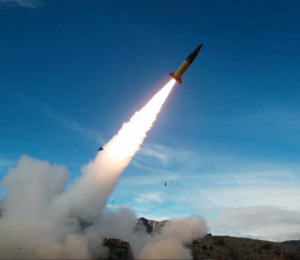 Atacms long-ranges missiles capable of hitting targets 300km away had already arrived in Ukraine this month at the president’s direction, before the US security package was passed by Congress on Wednesday, the state department has said. Vedant Patel, a state department spokesperson, explained that the weapons were part of a March aid package for Ukraine – not the one just approved by Congress and signed by Joe Biden. “We did not announce this at the onset in order to maintain operational security for Ukraine at their request.”
Atacms long-ranges missiles capable of hitting targets 300km away had already arrived in Ukraine this month at the president’s direction, before the US security package was passed by Congress on Wednesday, the state department has said. Vedant Patel, a state department spokesperson, explained that the weapons were part of a March aid package for Ukraine – not the one just approved by Congress and signed by Joe Biden. “We did not announce this at the onset in order to maintain operational security for Ukraine at their request.”
Ukraine has begun using the long-range Atacms, bombing a Russian military airfield in Crimea last week and Russian forces in another occupied area in recent days, two US officials have told the Associated Press on condition of anonymity. One of them said the Biden administration previously warned Russia that if it used long-range ballistic missiles in Ukraine, Washington would provide the same capability to the Ukrainians. Russia has since done so.
Separately, Adm Christopher Grady, vice-chairman of the US joint chiefs of staff, told the Associated Press that long-range weapons would help Ukraine take out Russian logistics and troop concentrations behind the frontlines. He explained how the decision to supply them was considered carefully and at length. “I think the time is right, and the boss [President Biden] made the decision the time is right to provide these based on where the fight is right now.”
- April 20, 2024
Breaking News: House Passes $60 Billion Ukraine Aid package
The House on Saturday passed a multi-country aid bill in the sum of $95 billion in foreign aid for Ukraine, Israel and Taiwan.
Republican House Speaker Mike Johnson put his job on the line, with full democratic party support, to advance the long-stalled Ukraine aid package and in defiance of far-right hard-liners within his own party who up until today have successfully delayed and obstructed Ukraine aid designed to rescue the Country’s flagging war effort. Other Country funding for the past four months including passage of strategic and aid-essential three-country funding package are also are part of the funding packages. The bills now go back to Senate for a final vote and approval.
U.S. Military Aid for Ukraine is set to begin re-supplying Ukraine with essential military supplies and amendments, including Patriot air defense missiles, already in Europe awaiting the go-ahead to begin resupply operations. What would $60 billion buy? Lots of air-defense missiles and artillery ammunition, according to the Pentagon.
The $95 billion package for Ukraine, Israel and the Indo-Pacific region, the bill package includes a provision to transfer frozen Russian assets to Ukraine, and sanctions against Hamas and Iran.
The Ukraine aid package, announced on March 12, included Stinger antiaircraft missiles, guided rockets for HIMARS launch vehicles, small anti-tank rockets and 155-mm artillery ammunition that included cluster munition rounds.
U.S. General Ryder was asked about a nonbinding measure in the House legislation to send Kyiv weapons called ATACMS, which have been the Pentagon’s longest-range ground-launched guided missiles since the late 1980s. The Biden administration agreed to provide a small number of those missiles last year, and Ukrainian forces used them to strike two air bases in Russian-occupied territory in October. Ukraine’s special operations forces said the attack damaged runways and destroyed nine Russian helicopters among other targets.
- April 19, 2024
On Friday, the rule for considering the bill — historically a straight party-line vote — passed with more Democratic than Republican support, but it also won a majority of G.O.P. votes, making it clear that despite a pocket of deep resistance from far-right Republicans, there is broad bipartisan backing for the $95.3 billion package. One of the four funding bills provides $60 billion for Ukraine. Most of the money goes to U.S. weapons manufacturers to build back depleted U.S. weapons supplies, and about 20 percent of that goes directly to the country in the form of a loan. The president can cancel Ukraine’s debt, however, after Nov. 15.
But it came only after Speaker Mike Johnson put his job on the line by turning to Democrats in a significant breach of custom in the House, further imperiling his position even as he paved the way for the legislation to be voted on and approved.
On the House floor, Democrats held back their votes until it was clear there was not enough Republican support for the measure to pass without their backing, and then their “yes” votes began pouring in. Ultimately, 165 Democrats voted for the measure, more than the 151 Republicans who supported it. Despite threats to Johnson’s job, the speaker decided to rely on Democrats to muscle through his aid package.
Democratic Leader Hakeem Jeffries (D-N.Y.) made the call late Thursday night to “do what is necessary” to provide the votes to advance the legislation. It was a significant decision considering that Johnson has slow-walked the aid package and remained noncommittal about a path forward until just this week.
- April 18, 2024
Calls to support Ukraine’s defence against Russian air strikes have grown after at least 17 people died when three missiles hit the centre of Chernihiv, a city in northern Ukraine near the border with Russia.
The German chancellor, Olaf Scholz, on Wednesday urged his fellow EU leaders to follow Germany’s lead and send Ukraine more Patriot air defence systems. Germany on Saturday announced it was sending an additional Patriot battery. “This is immediately useful, we want to encourage others to do the same,” said Scholz as he arrived for an EU summit in Brussels. “Now it is about doing it quickly and not at some point in the future.”
Nato’s chief, Jens Stoltenberg, told member countries that they should further strain their stockpiles to help support Ukraine. “If allies face a choice between meeting Nato capability targets and providing more aid to Ukraine, my message is clear: send more to Ukraine,” he said on Wednesday.
The Republican House Speaker, Mike Johnson, is pushing ahead with his plan to hold votes on four separate foreign aid bills this week, despite two radical right Republicans threat to oust him if he advances a Ukraine funding proposal.
Shortly after noon on Wednesday, the rules committee posted text for three bills that would provide funding for Ukraine, Israel and Taiwan. The separation of the Senate-passed combined funding package, Johnson created three discreet country funding proposals. Passed in the Republican controlled House, the surviving bills would be forced to return to Senate (once again) for a confirmation vote. This newly added process extra step will add time and political risk in the process to pass an overdue and sorely needed Ukraine military funding package for 2024.
- April 16, 2024
Ukraine’s Big Vulnerabilities: Ammunition, Soldiers and Air Defense
The shortages add up to a dire situation for Ukraine in the third year of the war, presenting commanders with near impossible choices on how to deploy limited resources.
Ukraine’s top military commander has issued a bleak assessment of the army’s positions on the eastern front, saying they have “worsened significantly in recent days.”
Russian forces were pushing hard to exploit their growing advantage in manpower and ammunition to break through Ukrainian lines, the commander, Gen. Oleksandr Syrsky, said in a statement over the weekend.
“Despite significant losses, the enemy is increasing his efforts by using new units on armored vehicles, thanks to which he periodically achieves tactical gains,” the general said.
At the same time, Ukraine’s energy ministry told millions of civilians to charge their power banks, get their generators out of storage and “be ready for any scenario” as Ukrainian power plants are damaged or destroyed in devastating Russian airstrikes.
House Republicans continue to hold Ukraine rescue funding and military support hostage for an incoherent political agenda.
- April 12, 2024
Russia’s missile attacks on Ukraine’s energy system, the bombardment of its second-largest city and advances along the front are stoking worries that Kyiv’s military effort is nearing breaking point.
A dire shortage of ammunition due to a dysfunctional Republican-controlled U.S. House of Representatives failing in their legislative responsibilities to pass a Ukraine funding package, passed by the bi-partian Senate last month. Hanging above it all is the stalled $60 billion US aid package, a victim of infighting among House Republicans benefiting Putin. Should US funds not come through, there is no alternative for Ukraine at its darkest moment, the officials said. An unprecedented series of foreign officials have visited Washington recently and appealed to congressional Republicans to approve more aid for Ukraine.
In the meantime, Russian forces are benefiting from a widening gap in ammunition supplies, with Moscow set to secure 6 million shells this year with ramped-up production and supplies from North Korea and Iran, according to one official.
Manpower shortages are another problem for Ukraine along a 930 mile front and and with gaps in air defenses, altogether have placed Ukraine at its most fragile moment in over two years of war, according to Western officials.
The risk is a collapse of Ukrainian defenses, an event that would give Kremlin an opening to make a major advance for the first time since the initial stages of the conflict, at least one official said.
The next few months will amount to Ukraine’s toughest test, with a public growing exhausted of war, especially in the city of Kharkiv in the country’s east, which has been particularly targeted.
Krystyna Malieieva, who fled the city after Russia invaded and then returned, said the unpredictability of the attacks have struck fear into city residents, even if most don’t believe the Kremlin can take a metropolis whose prewar population was 1.5 million.
“There is very depressive mood in Kharkiv now,” Malieieva, the owner of a family center who returned in 2023 after a year in Croatia and the UK, said in an interview. “People started to return last year, new restaurants opened — and now I see people are fleeing again.”
- April 5th, 2024
Russian forces were advancing, and pushing back against them was “difficult”, said Oleksandr Syrskyi, commander of Ukraine’s armed forces.
Syrskyi said the situation in the Bakhmut area in the partially occupied eastern Donetsk region was particularly challenging, Reuters reported.
He said Russian forces are carrying out offensive operations day and night, using assault groups with the support of armoured vehicles, as well as assaults on foot.
Fierce battles are taking place east of the town of Chasiv Yar, which Ukraine still controls and which is located near the occupied city of Bakhmut.
Russian forces are trying to break through defensive lines there, Syrskyi said on the messaging app Telegram, adding that “Chasiv Yar remains under our control, all enemy attempts to break through to the settlement have failed”.
Near Avdiivka, another city in the Donetsk region held by the Russians, the fiercest battles were occurring in Pervomaiskyi and Vodyanyi, according to the official. He also said the situation is tense on the southern and north-eastern parts of the front line.
Meantime, US Treasury Secretary Janet Yellen has warned of “significant consequences” for China if its companies provide material support for Russia in its war against Ukraine. British Foreign Secretary David Cameron is expected to visit the United States next week in order to persuade Republican politicians to approve a $60bn package of aid for Ukraine that they have delayed in the US Congress for months.
Ukraine is a country clinging to independence in the face of a broad and bloody assault intent on toppling Ukraine’s democratic government and scramble the post-cold war world order. Vladimir Putin is determined to overthrow Ukraine’s government and replace it with a regime of his own.
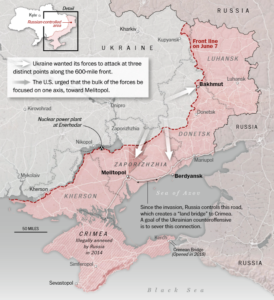 The invasion represents Putin’s boldest effort yet to redraw the map of Europe and revive Moscow’s cold war-era influence. It has triggered an international response including an uncharacteristically unified NATO response and direct sanctions on Putin. Military and economic aid from the United States, and direct support from Ukraine’s neighboring NATO countries further threatened by Russia’s invasion are proving essential to Ukraine’s self-defense.
The invasion represents Putin’s boldest effort yet to redraw the map of Europe and revive Moscow’s cold war-era influence. It has triggered an international response including an uncharacteristically unified NATO response and direct sanctions on Putin. Military and economic aid from the United States, and direct support from Ukraine’s neighboring NATO countries further threatened by Russia’s invasion are proving essential to Ukraine’s self-defense.
Russia’s invasion of Ukraine has also abruptly transformed the world. Millions of people have already fled. Global food and grain exports have been disrupted, and a revived Iron Curtain is grinding into place. As economic warfare deepens in step with the military conflict, Ukrainian civilian casualties rise along with evidence of horrific war crimes by committed by Russian military forces.
As the war enters its third painful year (2024), Ukraine’s leadership is fighting along a 930-mile front with the Russians, fighting to win crucial supplies from allies and fighting among itself. It wants to avoid being forced to negotiate unpalatable peace terms, even though the pressure to do so is building.
The Ukraine war is far from Hawaii’s shores, but the implications of this war are global, including an embargo on importing Russian oil which Hawaiian Electric combustion power plants depend. Ukraine’s war-disrupted grain exports (the breadbasket of the world) drive up global food prices and inflation.
It’s been two years since Russia invaded Ukraine, with tens of thousands having perished in a war that’s ushered in the most geopolitically dangerous era in decades. More violence has erupted, including the disastrous conflict between Israel and Hamas. Tensions everywhere seem to be rising. The Kremlin could deploy a nuclear weapon into space as early as this year, the US told allies, just before the Biden administration unveiled a far-reaching sanctions package against Russia.
One the second anniversary of the Russian invasion Ukraine, President Joe Biden told the world:
The brave people of Ukraine fight on, unbowed in their determination to defend their freedom and future. Nato is stronger, larger, and more united than ever. And the unprecedented 50-nation global coalition in support of Ukraine, led by the United States, remains committed to providing critical assistance to Ukraine and holding Russia accountable for its aggression. The American people and people around the world understand that the stakes of this fight extend far beyond Ukraine.
Ukraine on Saturday (Feb. 24,2024) marked two years since Russia’s invasion, entering a new year of war weakened by a lack of western aid and ammunition while Russia is emboldened by fresh gains. President Volodymyr Zelenskiy said on Friday that decisions on arms supplies had to be “the priority”. The anniversary of the invasion on 24 February 2022 will see visits by western leaders including the European Commission chief, Ursula von der Leyen.
At the beginning of the War, Ukraine defied expectations by repelling a much larger invading Russian army, and preventing outright defeat, but international aid and military-supply deliveries have slowed, and soldiers under heavy artillery fire are dying in the thousands, sometimes for a few miles of land.
Overall, war aid remains uncertain for Kyiv due to far-right Republicans in Congress blocking a vital $60bn aid package, compounded by arms delivery delays promised by European allies.Meantwhile, grinding Russian advances and faltering Western backing for Kyiv has been a gift to Putin (the Russian leader) who’s recent lookout on the war has shifted from depressed to confident, convinced he now has the numbers to win the war and completed his conquer of Ukraine.
Seven troops from the 3rd Assault Brigade spoke to The Post about their final days under Russian assault inside the former Ukrainian stronghold. Their accounts drive home the urgency of Ukraine’s battlefield disadvantage as soldiers — far outnumbered by Russians — wait for Western weapon deliveries and troop reinforcements.
Two years of war have remade Russia.
Isolated from the West, it is now more dependent on China. Political repression is reminiscent of the grim days of the Soviet Union.
But Russia is not the economic shambles many in the West predicted when they imposed punishing sanctions over the invasion of Ukraine. Many Russians are pulling down their highest incomes in years.
Russian society has been refashioned in ways that have devastated some and lifted others. While government critics languish in jail and young men die in trenches at the front, other Russians — especially those willing to spout the official line — are feeling more optimistic than ever.
In the early months of the war, Putin’s military made grave mistakes, but it has regrouped. Russia fended off a Western-backed Ukrainian counteroffensive and has taken the initiative on the front, buoyed by frozen American aid for Ukraine. Still, Russia has sustained huge costs to get this far. It is far from controlling the four regions it claims to have annexed, let alone the rest of Ukraine, and Mr. Putin may need to carry out another draft. Putlin publically claims he would like to negotiate an end to the war, but skeptics see that as a ploy to undercut Western aid to Ukraine.


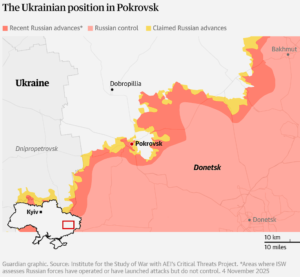

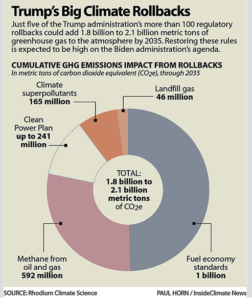




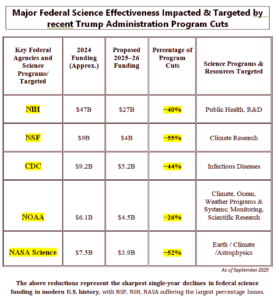
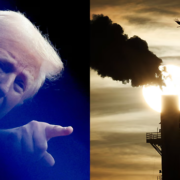
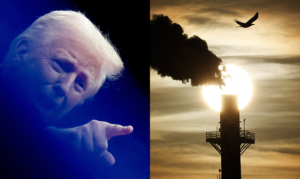 “We will drill, baby, drill,” the president said in his inaugural address, and so far he has stuck to his rhetoric.
“We will drill, baby, drill,” the president said in his inaugural address, and so far he has stuck to his rhetoric.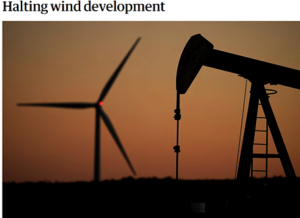 Trump has targeted, in a full-stop maneuver, policies enabling nation’s nascent offshore Wind Energy sector. Using false reasoning that denies the facts, Trump claims turbines are killing thousands of whales, but this president’s executive order is more than a Wind energy ban on ocean projects, he has gone further by
Trump has targeted, in a full-stop maneuver, policies enabling nation’s nascent offshore Wind Energy sector. Using false reasoning that denies the facts, Trump claims turbines are killing thousands of whales, but this president’s executive order is more than a Wind energy ban on ocean projects, he has gone further by 
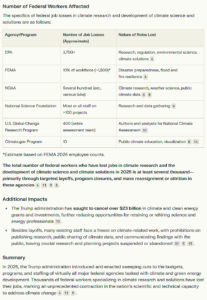

 President Trump’s “Big Bill” legislation now in final review in the Republican-controlled Senate would make far deeper cuts and lead to more people becoming medically-uninsured than previously proposed or imagined, with the nation’s Medicaid-dependent population feeling the weight of forthcoming government cuts to medical coverage and benefits.
President Trump’s “Big Bill” legislation now in final review in the Republican-controlled Senate would make far deeper cuts and lead to more people becoming medically-uninsured than previously proposed or imagined, with the nation’s Medicaid-dependent population feeling the weight of forthcoming government cuts to medical coverage and benefits.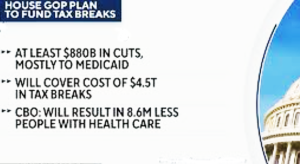 up, or qualified for an exemption. The Senate version applies this provision to the poor parents of children older than 14 in addition to childless adults without disabilities, the group targeted by the House version. The budget office estimated that that provision alone would reduce federal spending by more than $325 billion over the decade.
up, or qualified for an exemption. The Senate version applies this provision to the poor parents of children older than 14 in addition to childless adults without disabilities, the group targeted by the House version. The budget office estimated that that provision alone would reduce federal spending by more than $325 billion over the decade.
 The current attack on the highly successful IRA legislation includes was a package of taxpayer gifts directed at fossil-fuel and polluter interests. Most notable is the GOP’s financial elimination all EV (electric vehicle) tax credits, one of the many accomplishments of the 2023 bipartisan passage of the IRA clean energy bill.
The current attack on the highly successful IRA legislation includes was a package of taxpayer gifts directed at fossil-fuel and polluter interests. Most notable is the GOP’s financial elimination all EV (electric vehicle) tax credits, one of the many accomplishments of the 2023 bipartisan passage of the IRA clean energy bill. So the party of Gas-Oil-Polluters (GOP) eliminates tax credits for EVs, but, their not satisfied with just crippling the growth of clean transportation, their House bill also targets domestic solar and wind, and energy efficiency improvements from cars-to-refrigerators-to factories. For some unknown reason, today’s GOP power players view efficiency when applied to a sustainable economy as a waste of time and money that they are neither invested or interested in… and their priorities are wrong; period.
So the party of Gas-Oil-Polluters (GOP) eliminates tax credits for EVs, but, their not satisfied with just crippling the growth of clean transportation, their House bill also targets domestic solar and wind, and energy efficiency improvements from cars-to-refrigerators-to factories. For some unknown reason, today’s GOP power players view efficiency when applied to a sustainable economy as a waste of time and money that they are neither invested or interested in… and their priorities are wrong; period.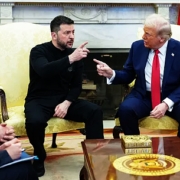
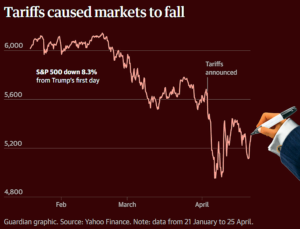
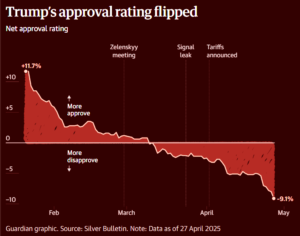
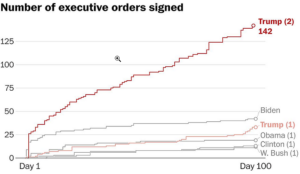 Trump’s record-breaking use of executive powers is too often thinly and repeatedly justified by the president and his supporters as following a so-called “voter mandate” which elevated Trump to the office of the presidency without guardrails or accountability. In reality, Trump’s win was marked by the slimmest of margins (one and a half percent).
Trump’s record-breaking use of executive powers is too often thinly and repeatedly justified by the president and his supporters as following a so-called “voter mandate” which elevated Trump to the office of the presidency without guardrails or accountability. In reality, Trump’s win was marked by the slimmest of margins (one and a half percent).

 Consumers were more pessimistic about current and future labor-market conditions as well as the outlook for incomes and business conditions. Perceptions of present and future financial situations worsened and the
Consumers were more pessimistic about current and future labor-market conditions as well as the outlook for incomes and business conditions. Perceptions of present and future financial situations worsened and the  Key Impacts on Hawaii’s Economy
Key Impacts on Hawaii’s Economy